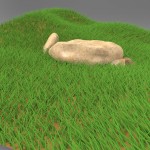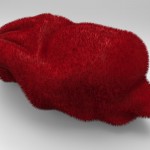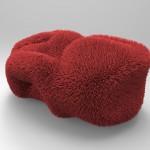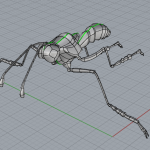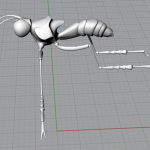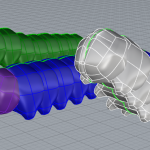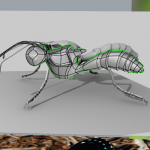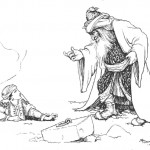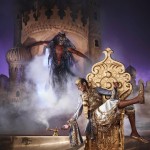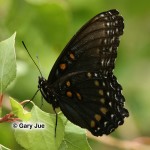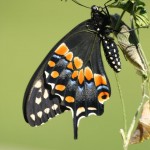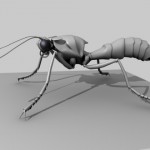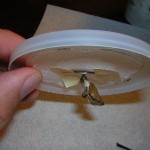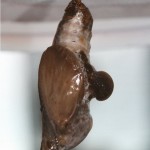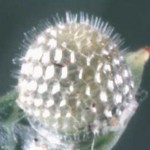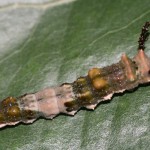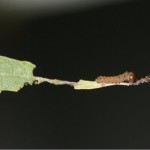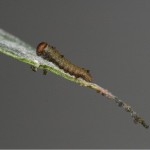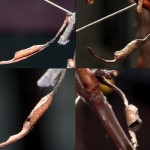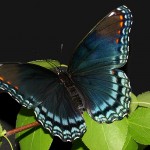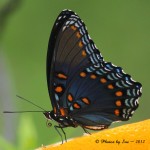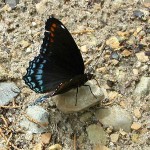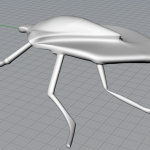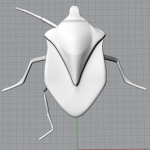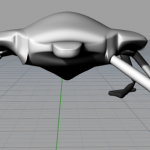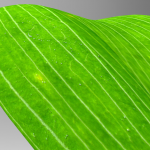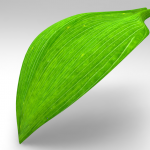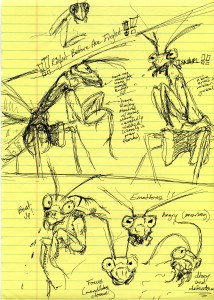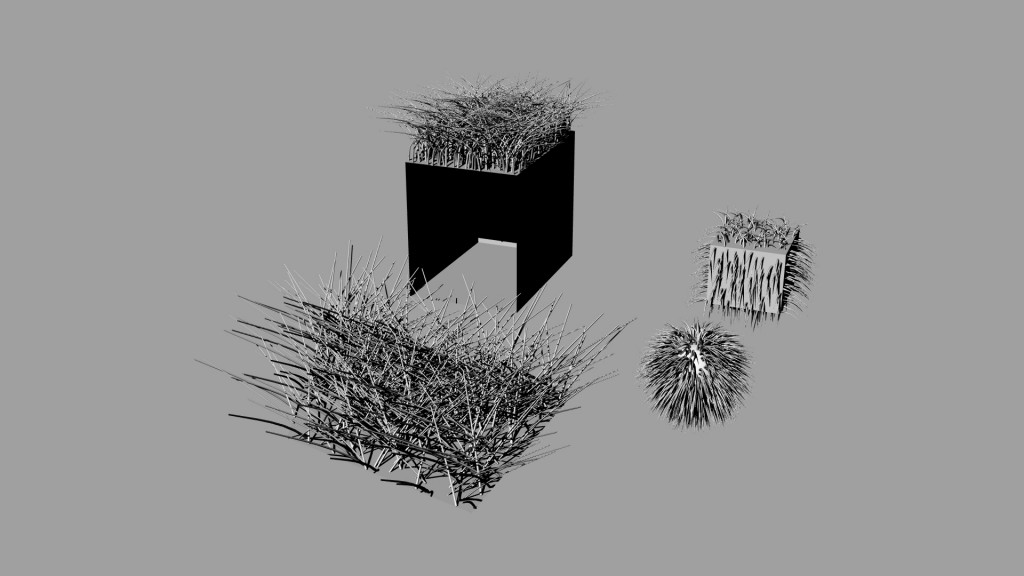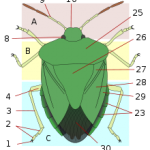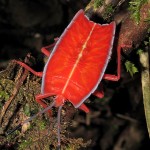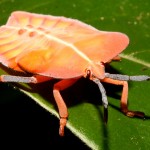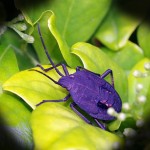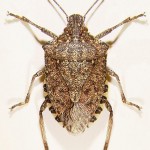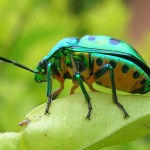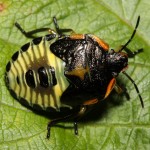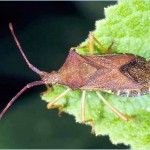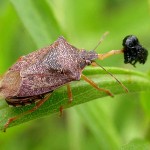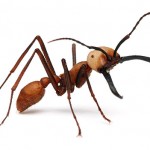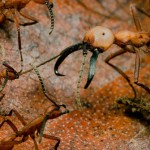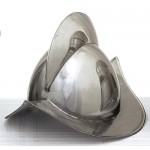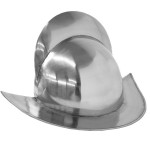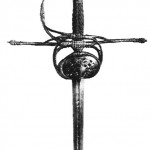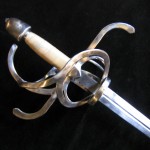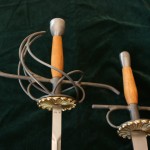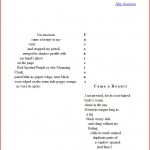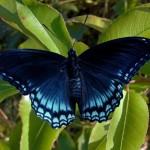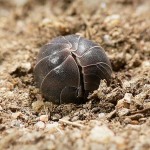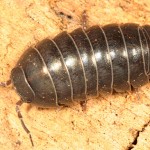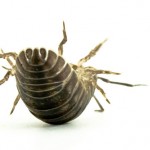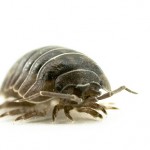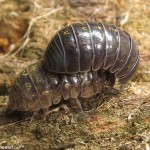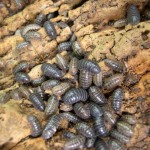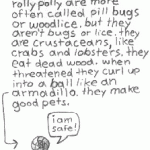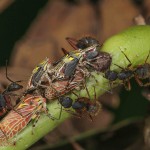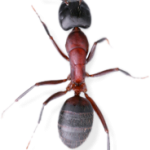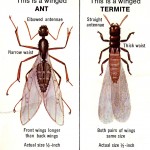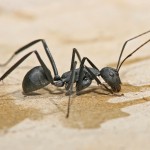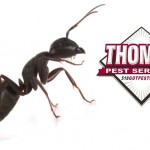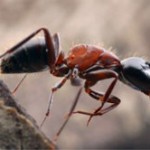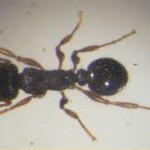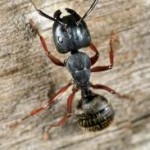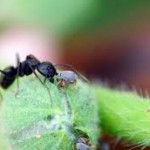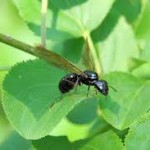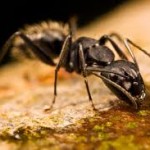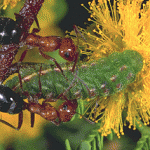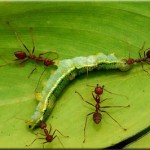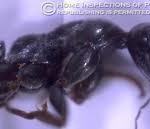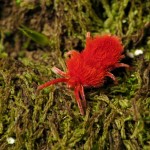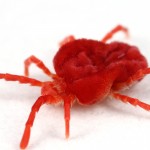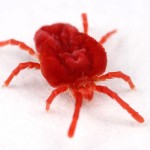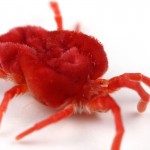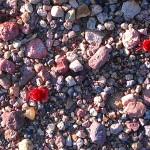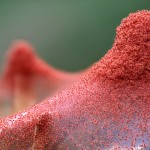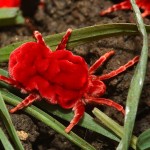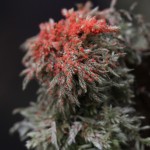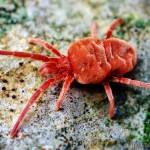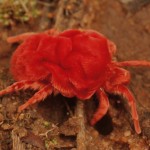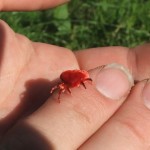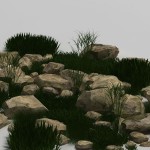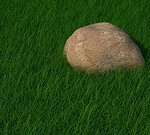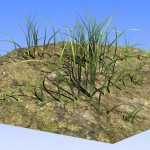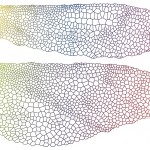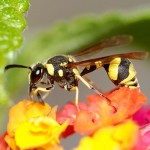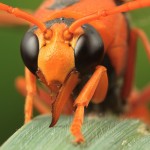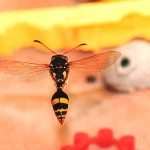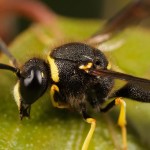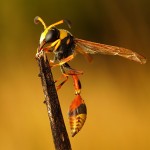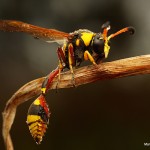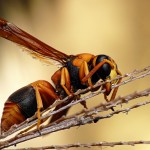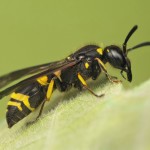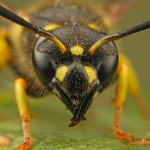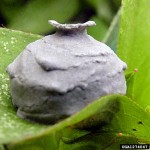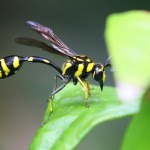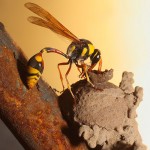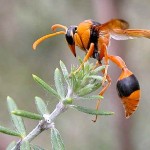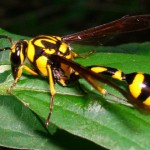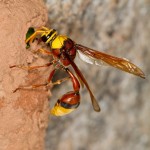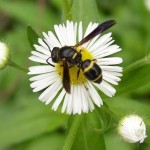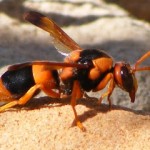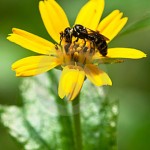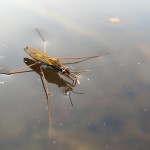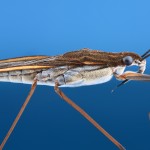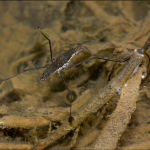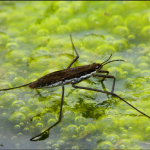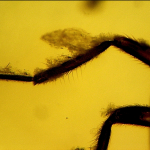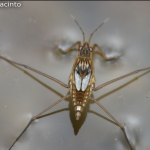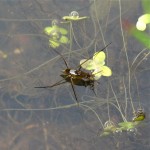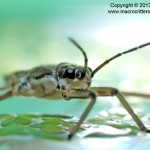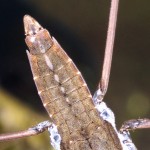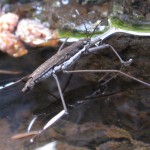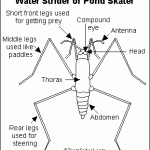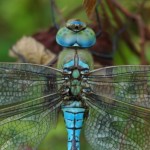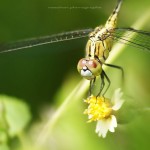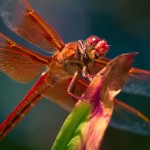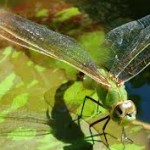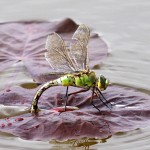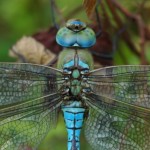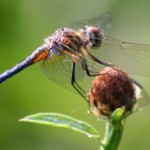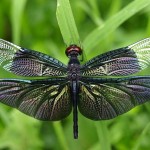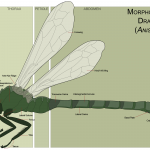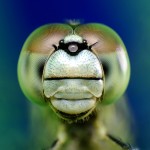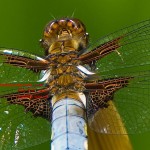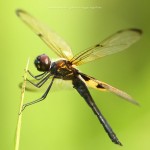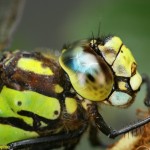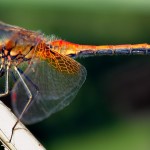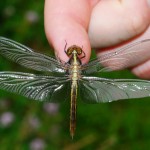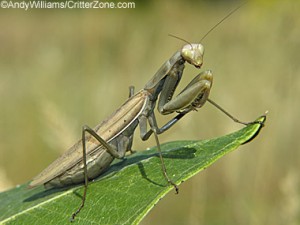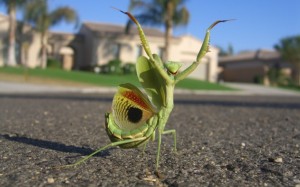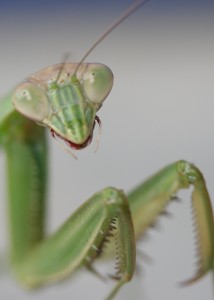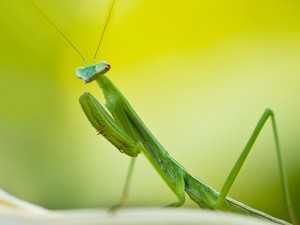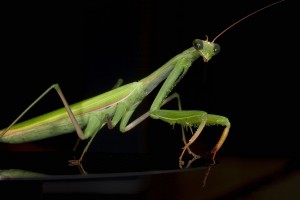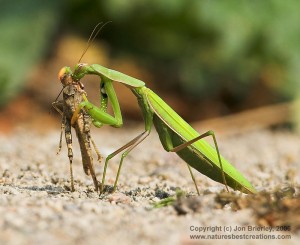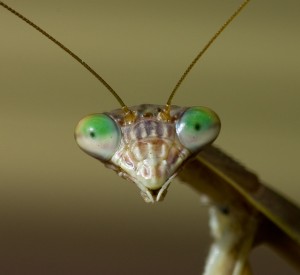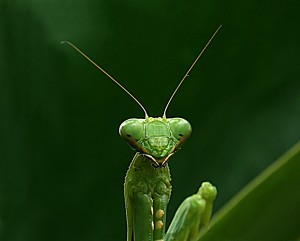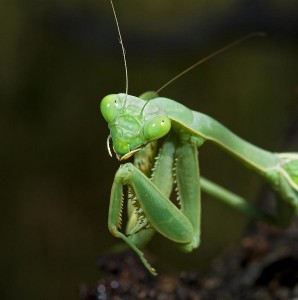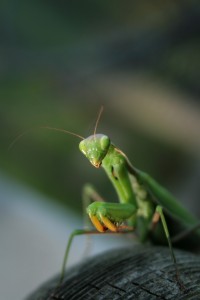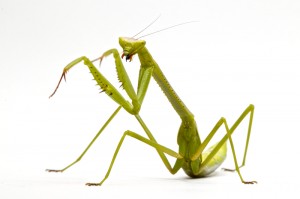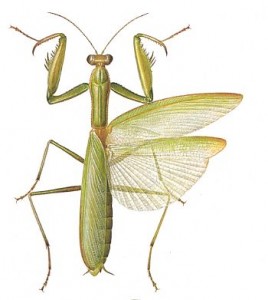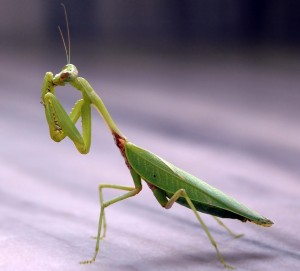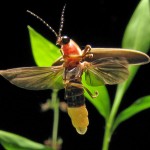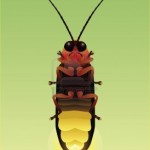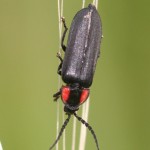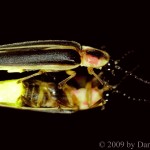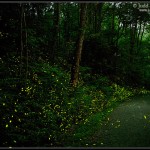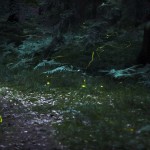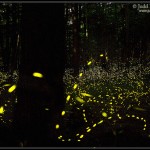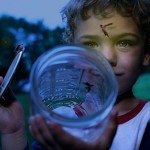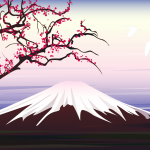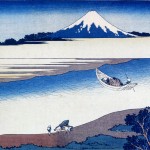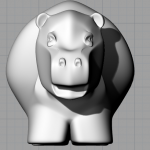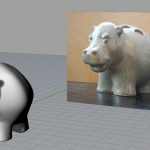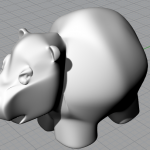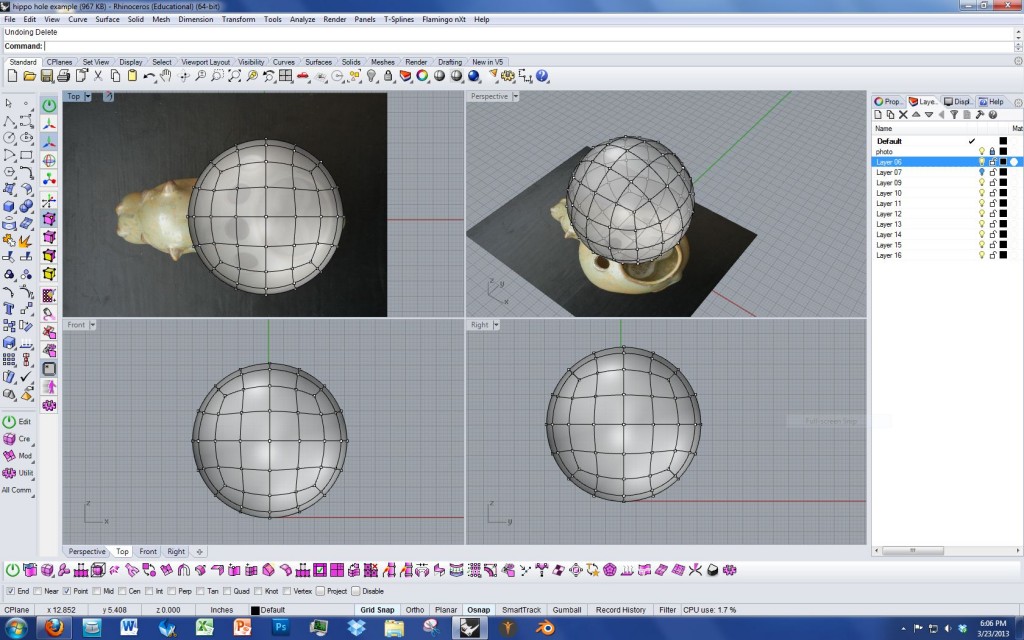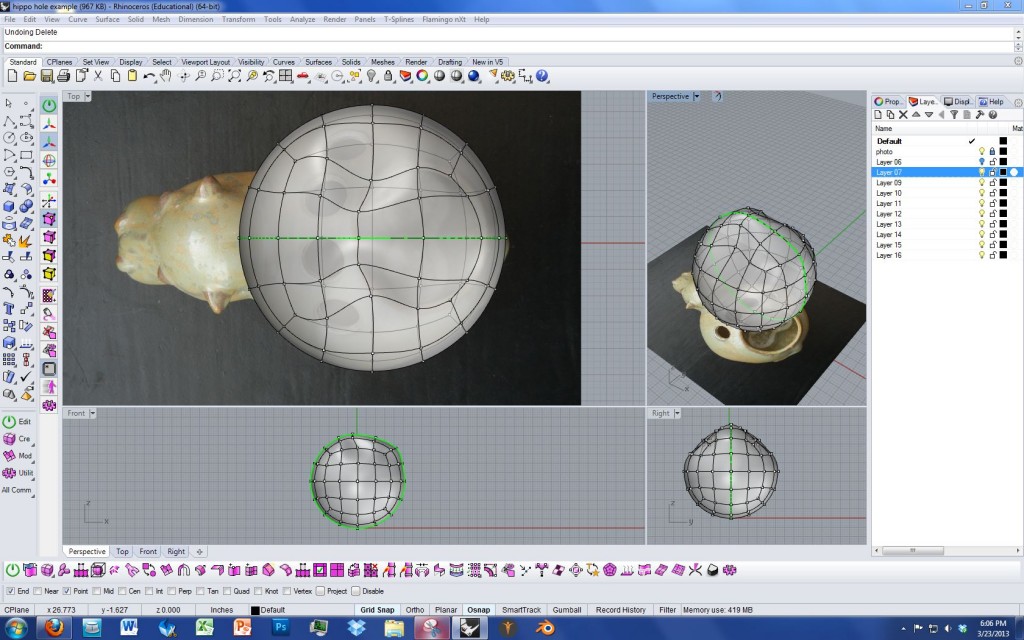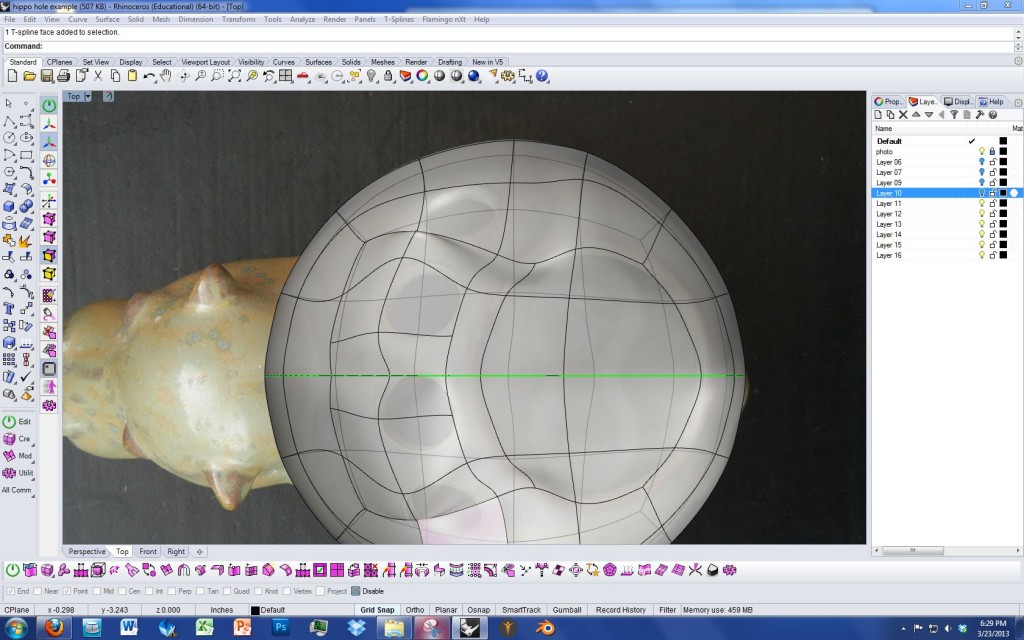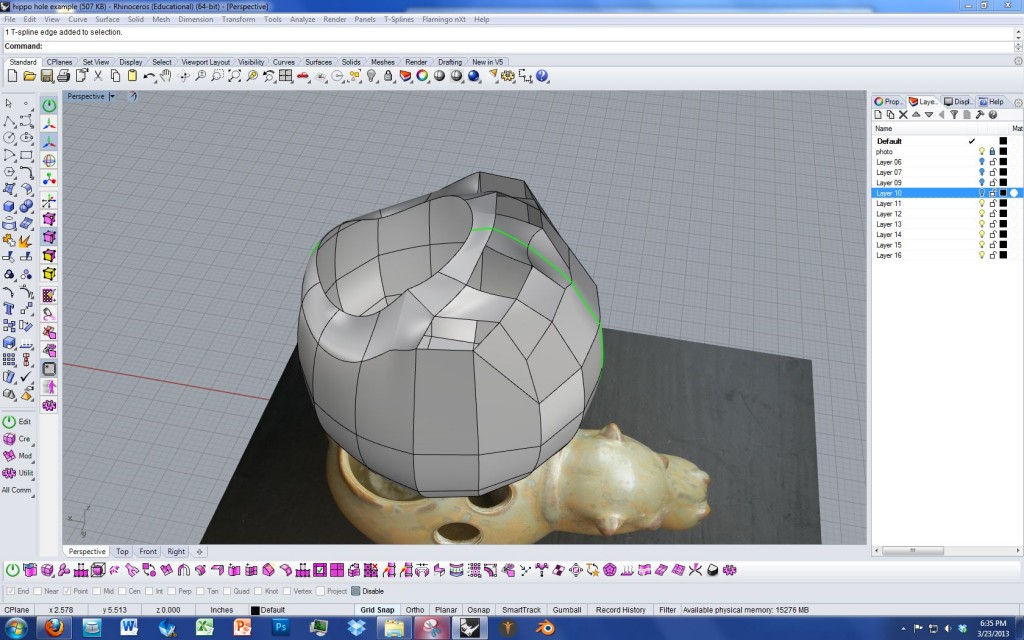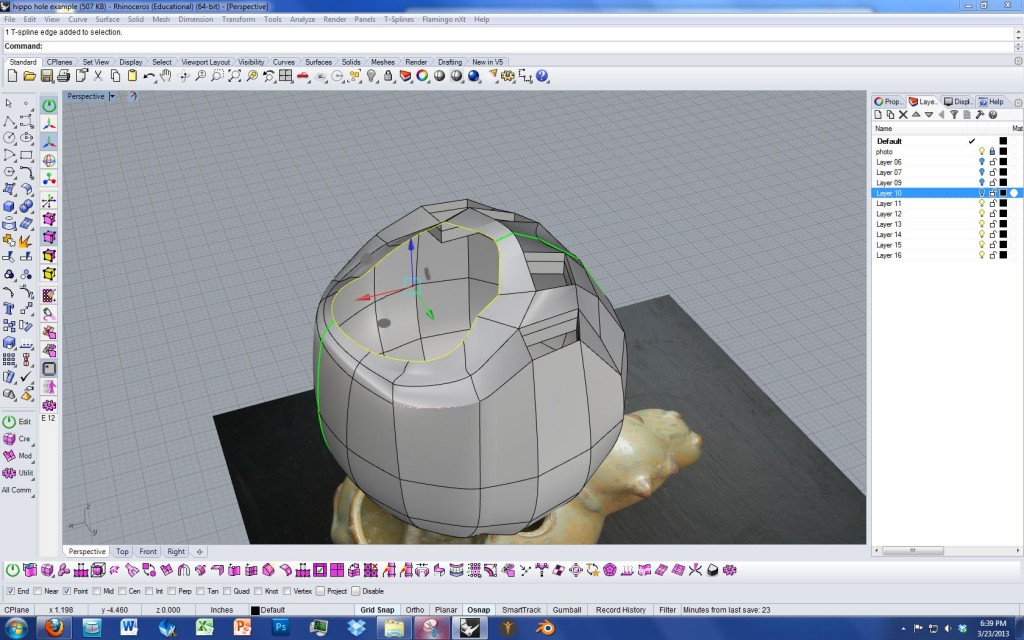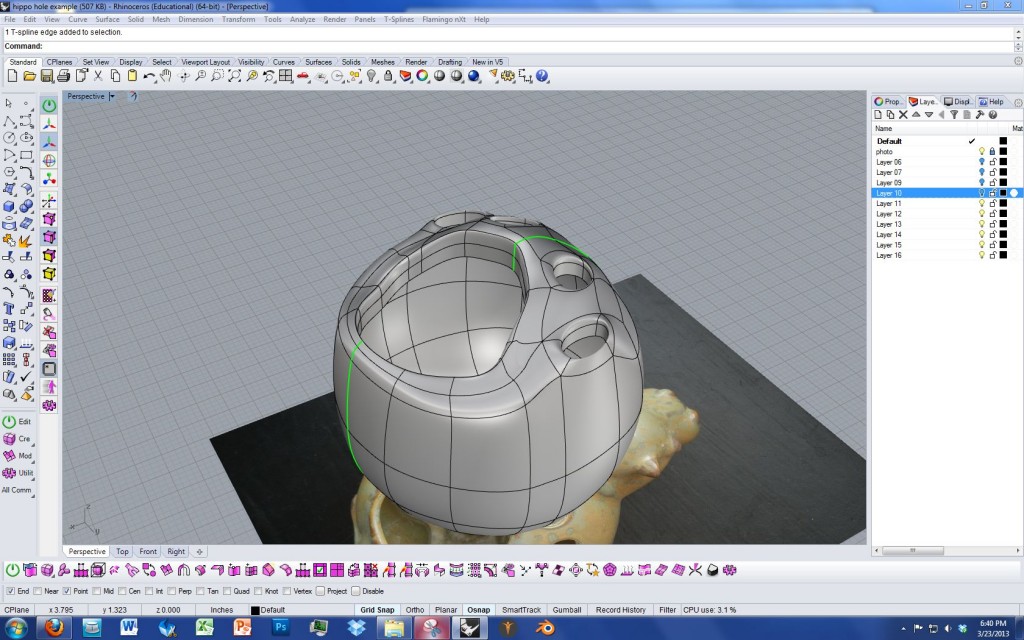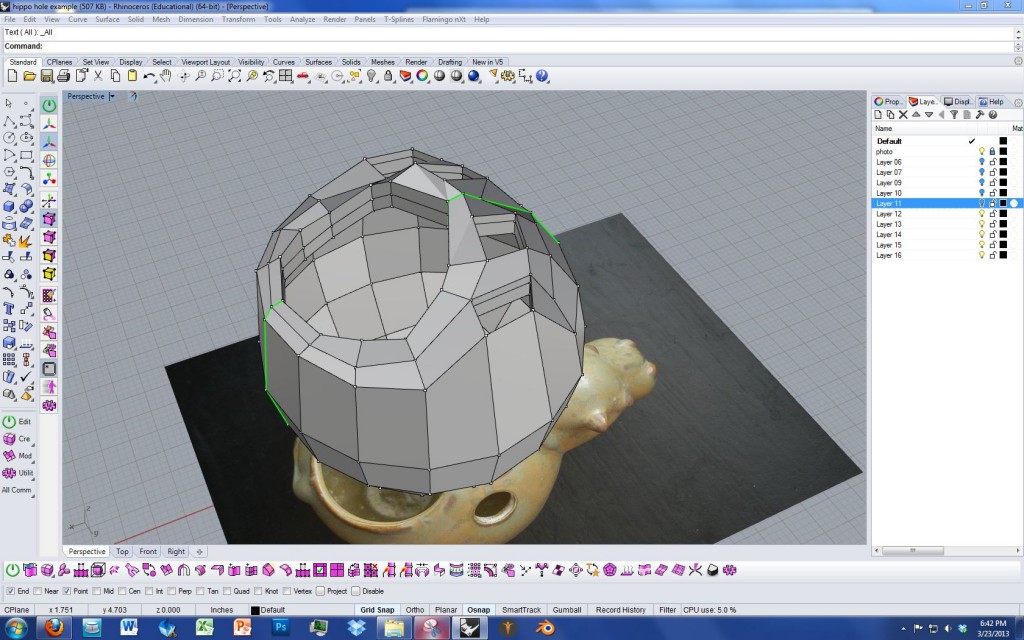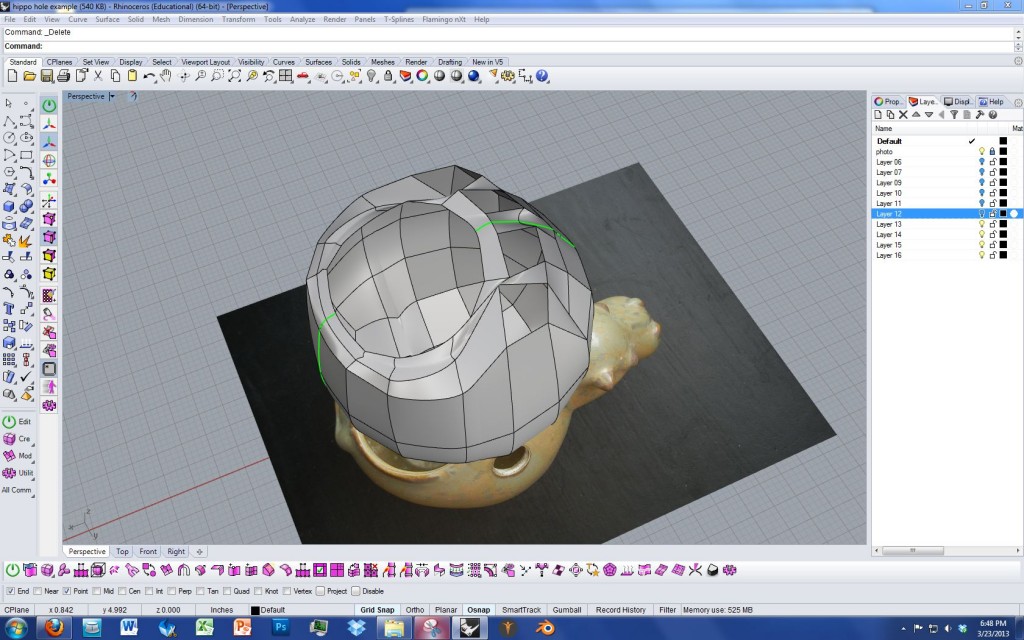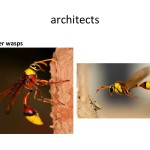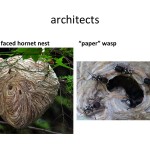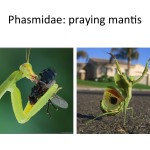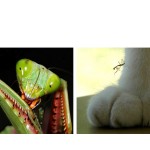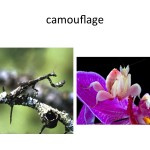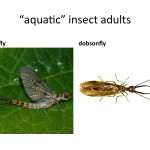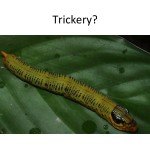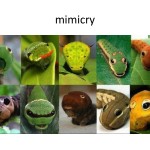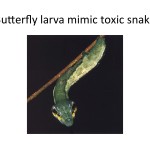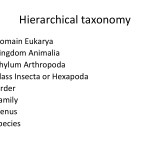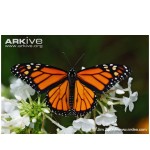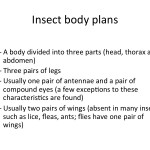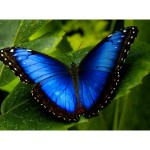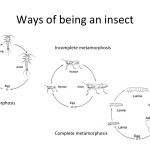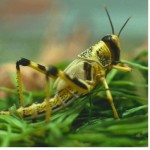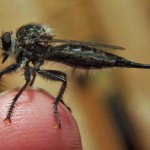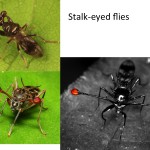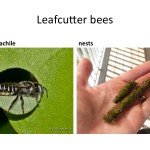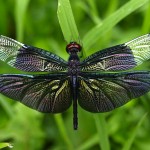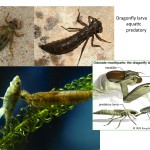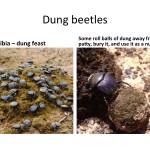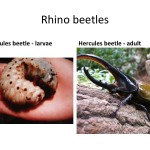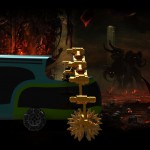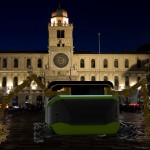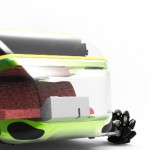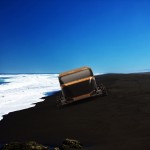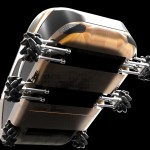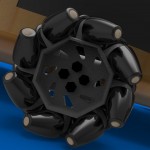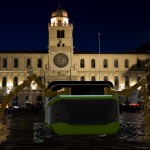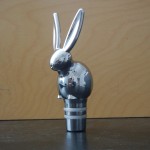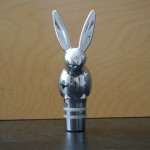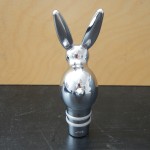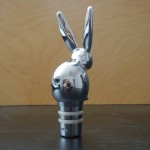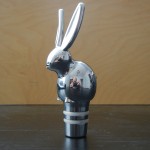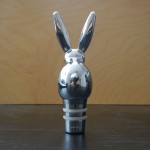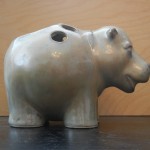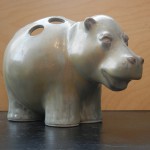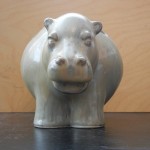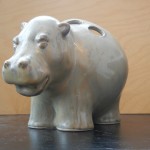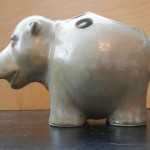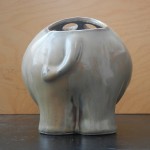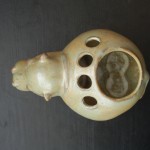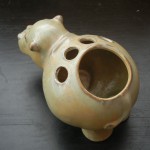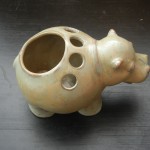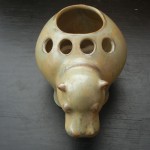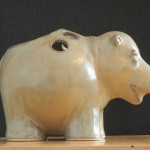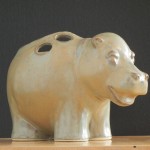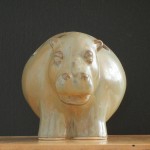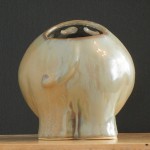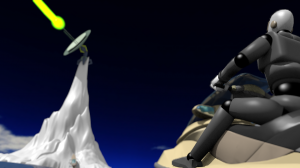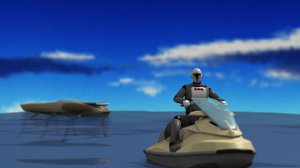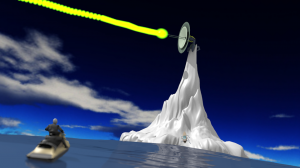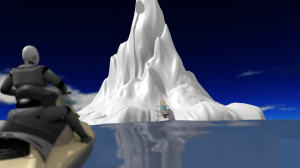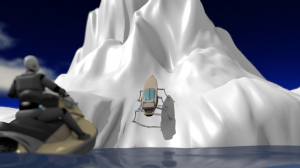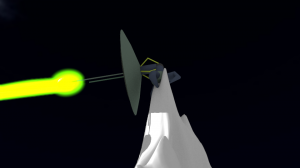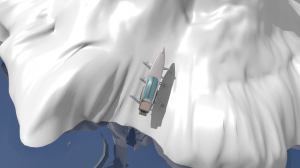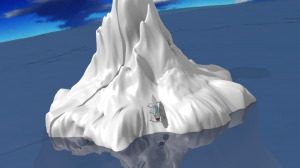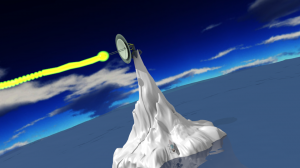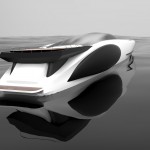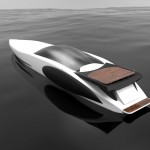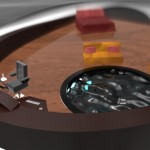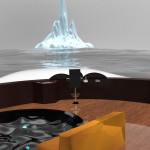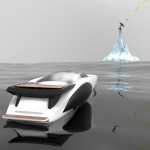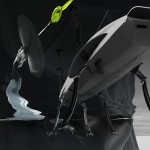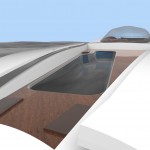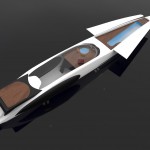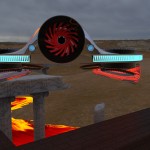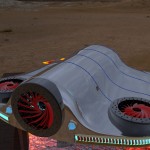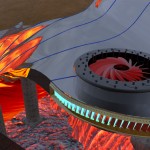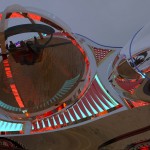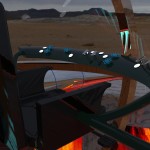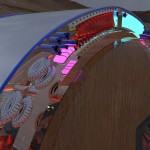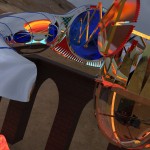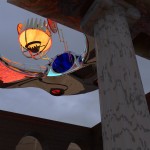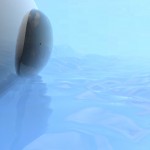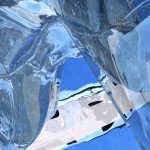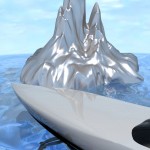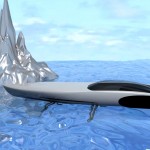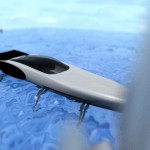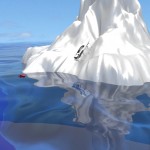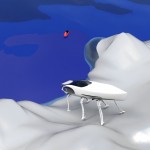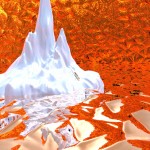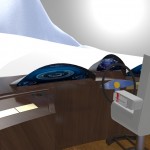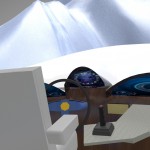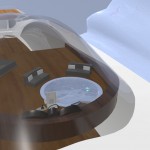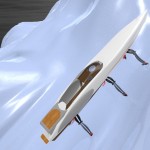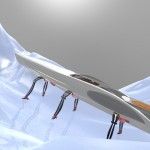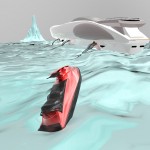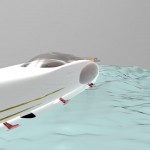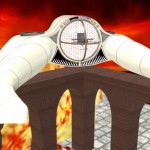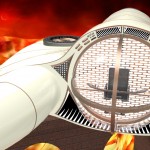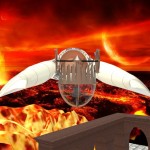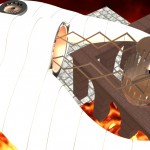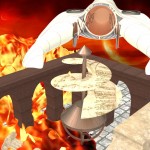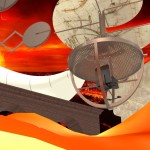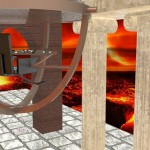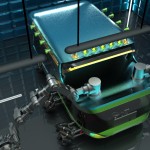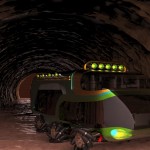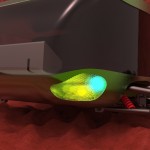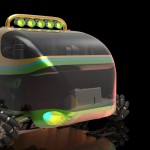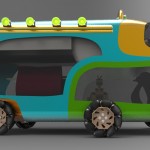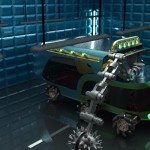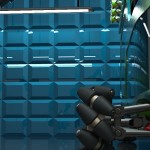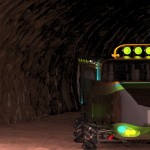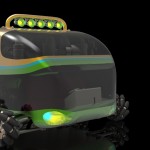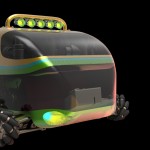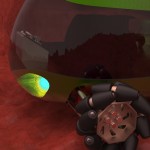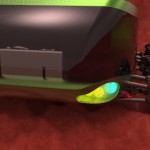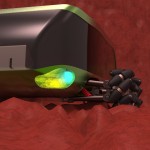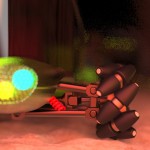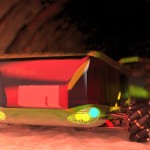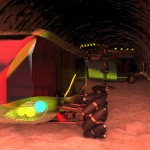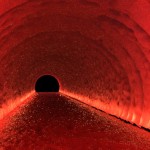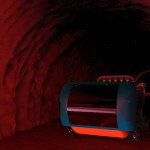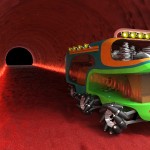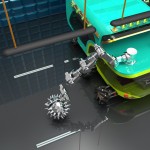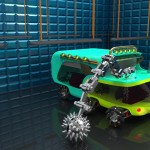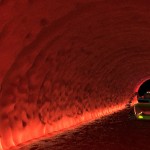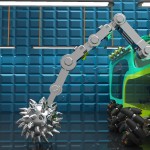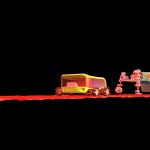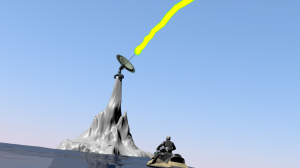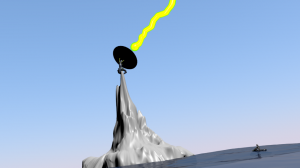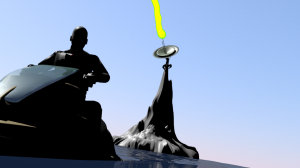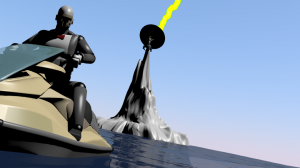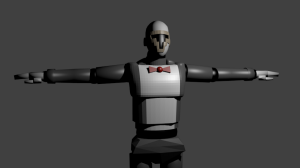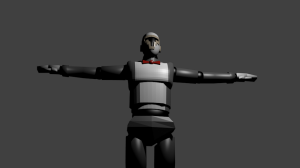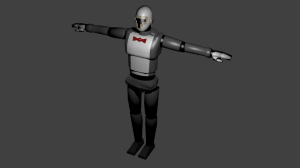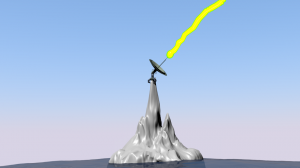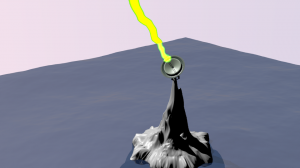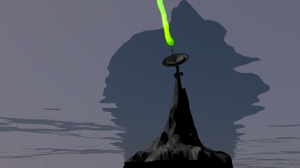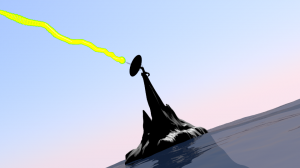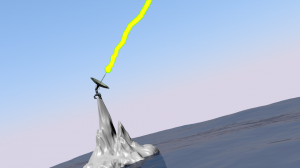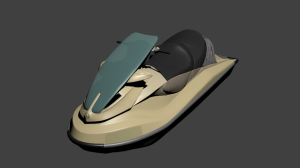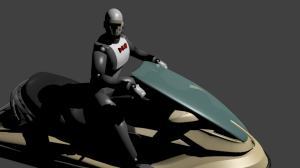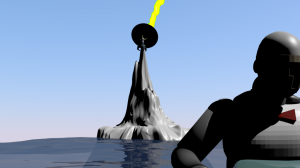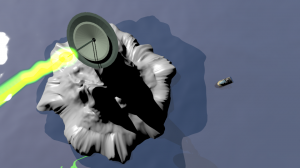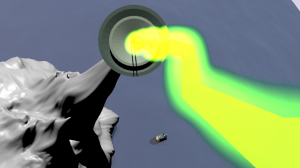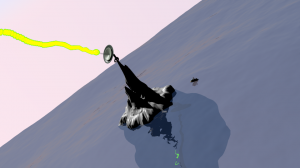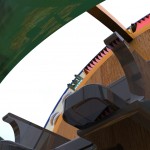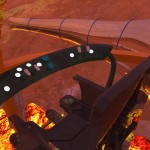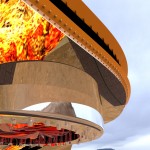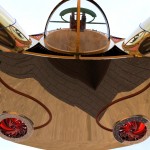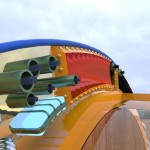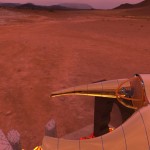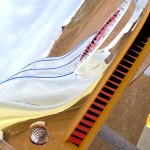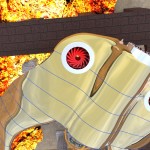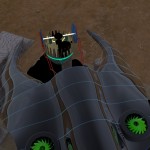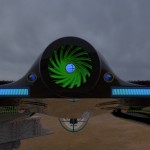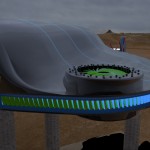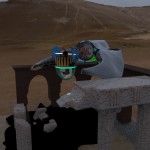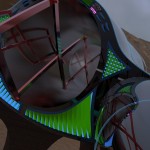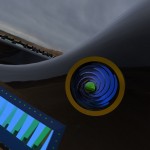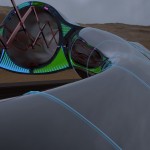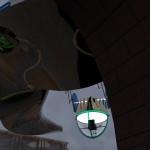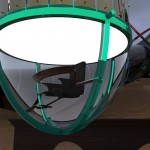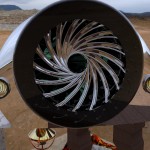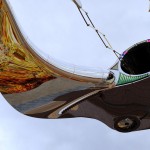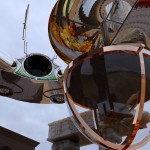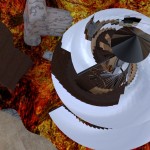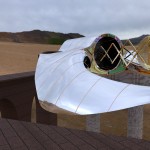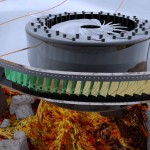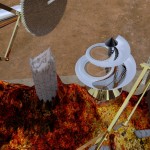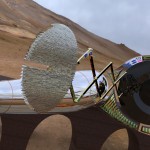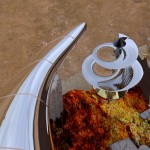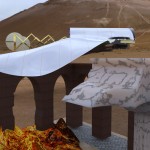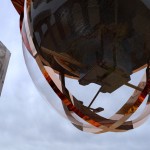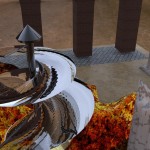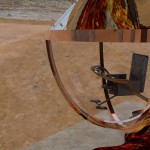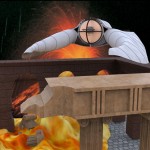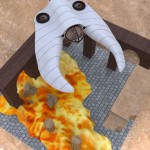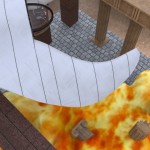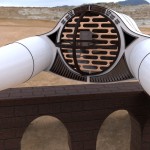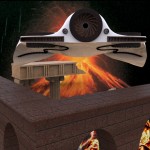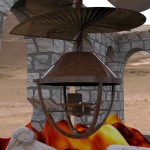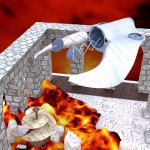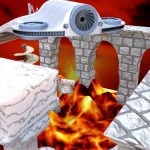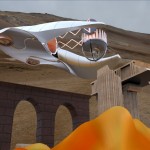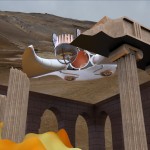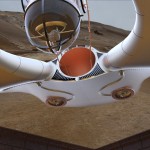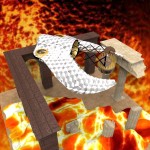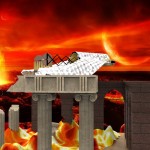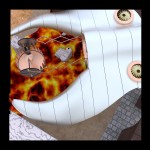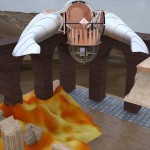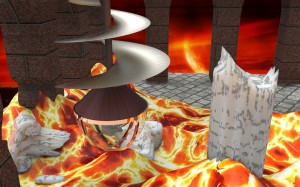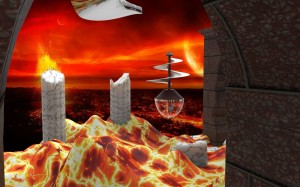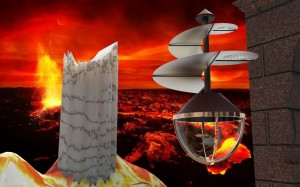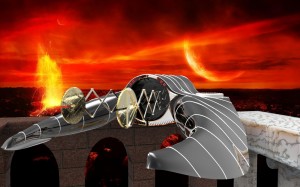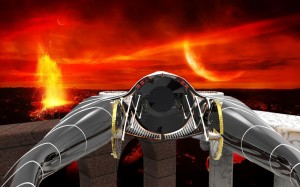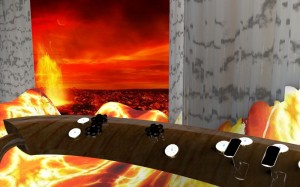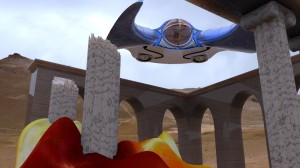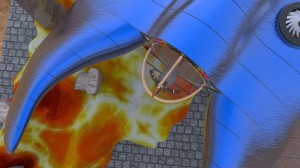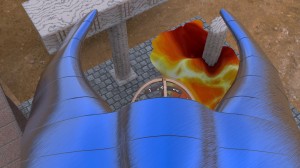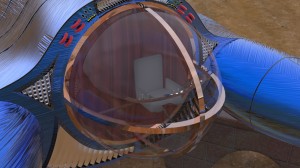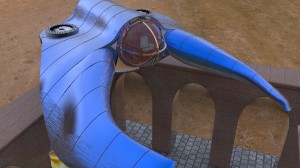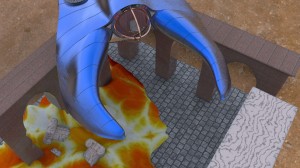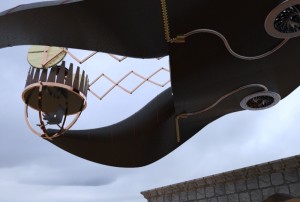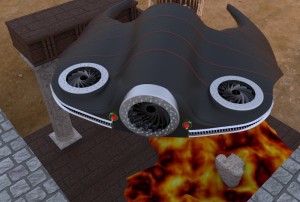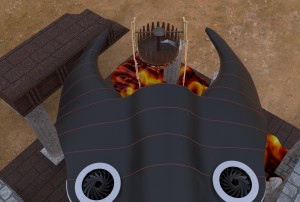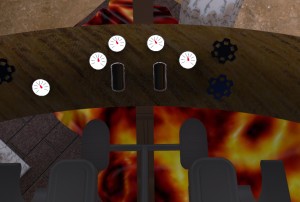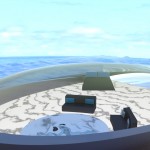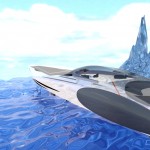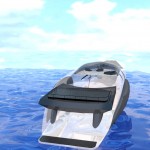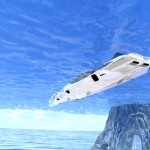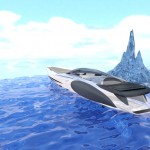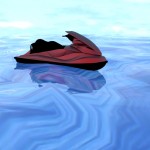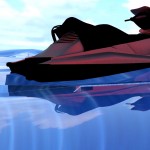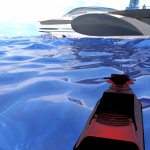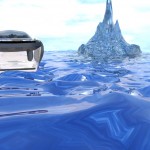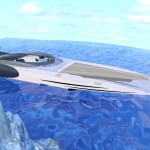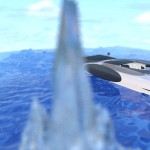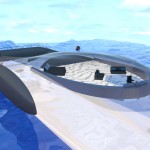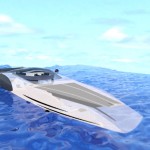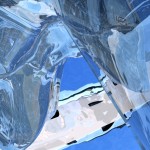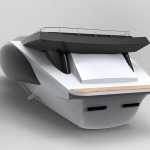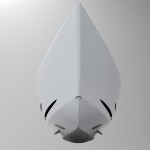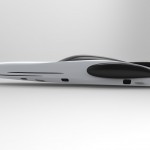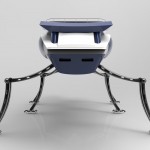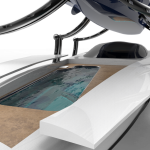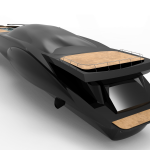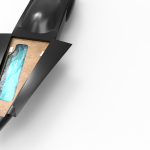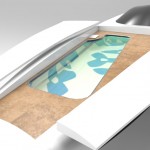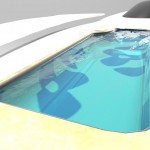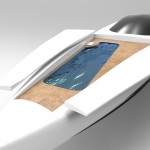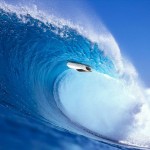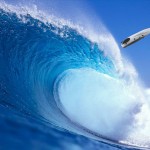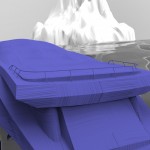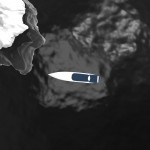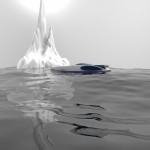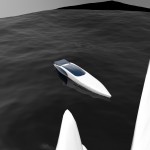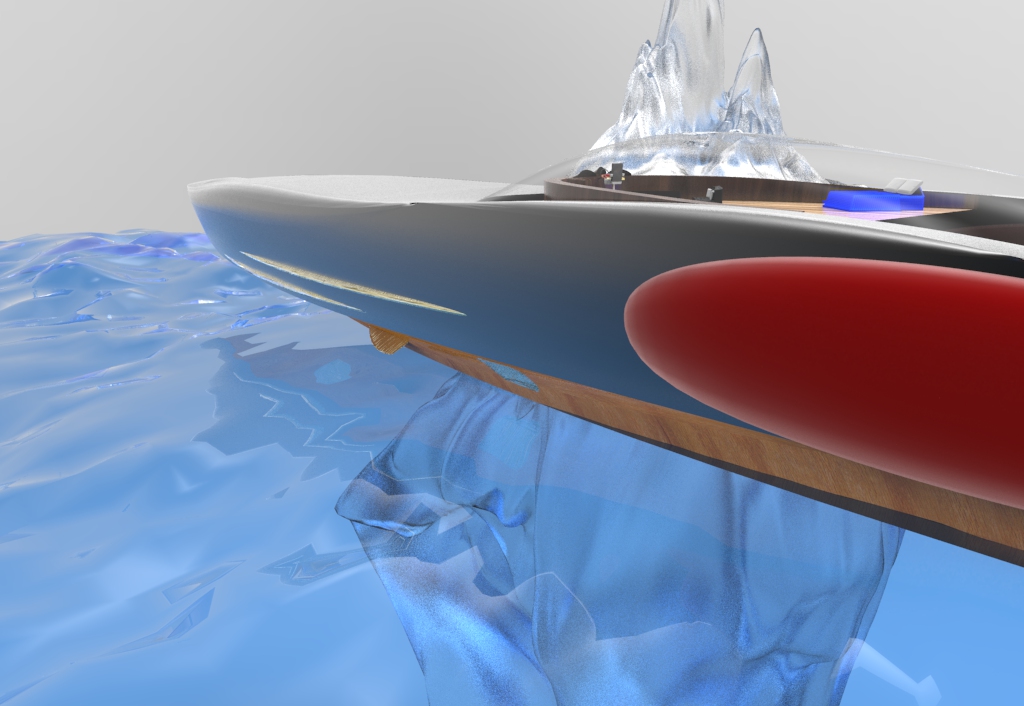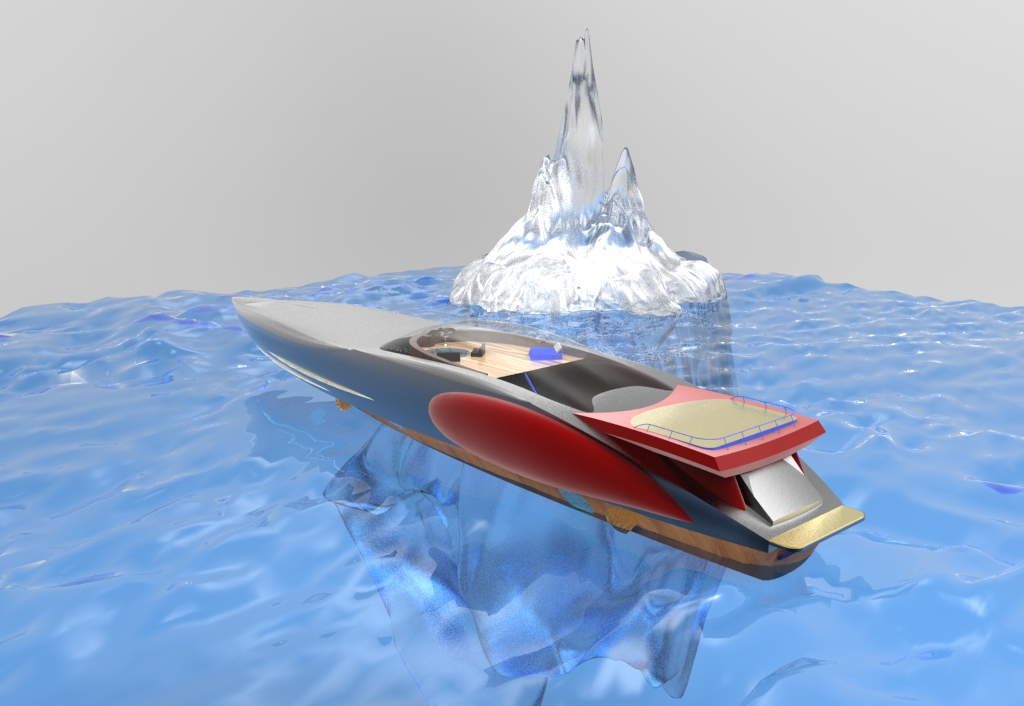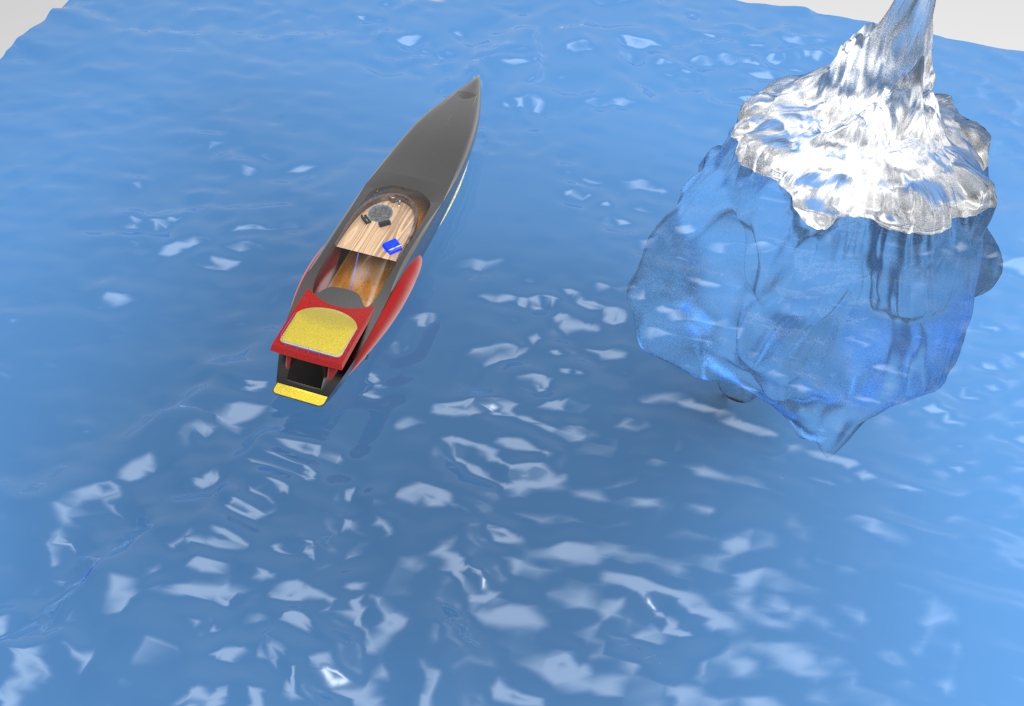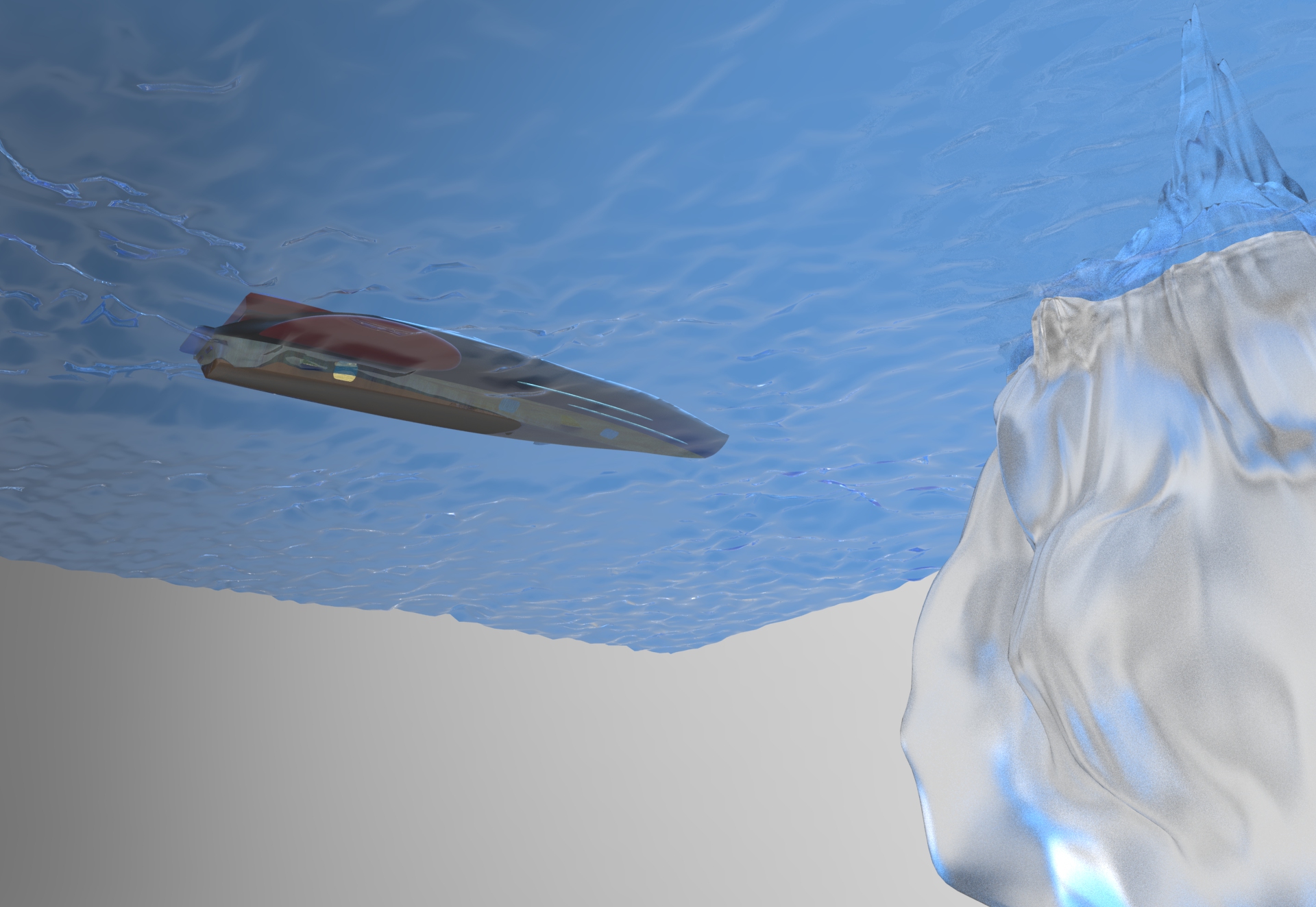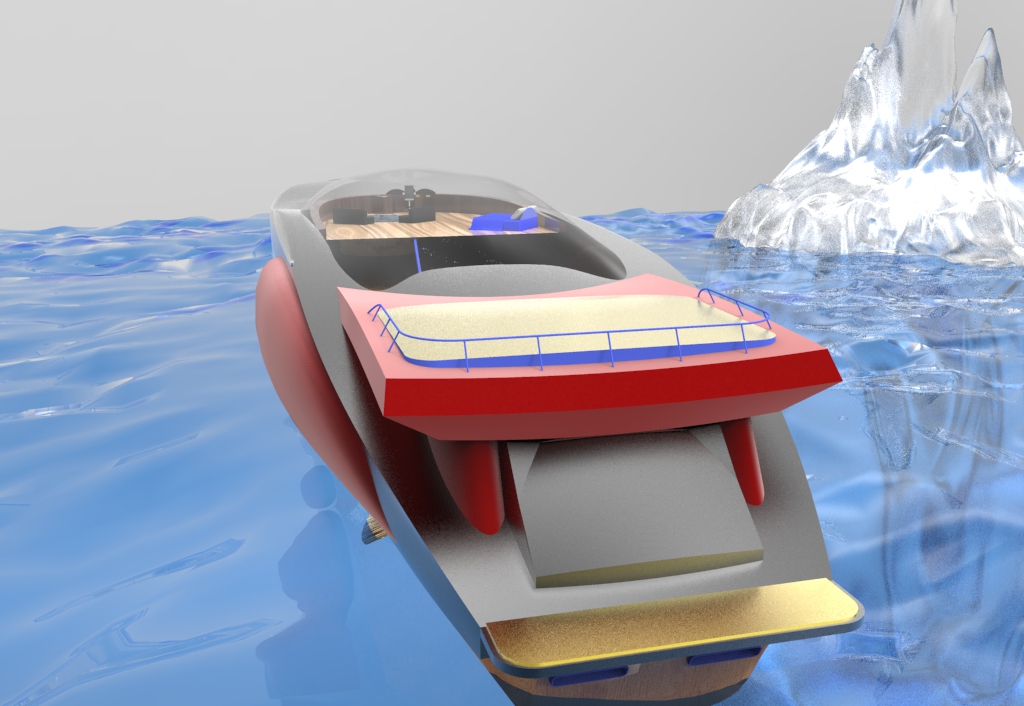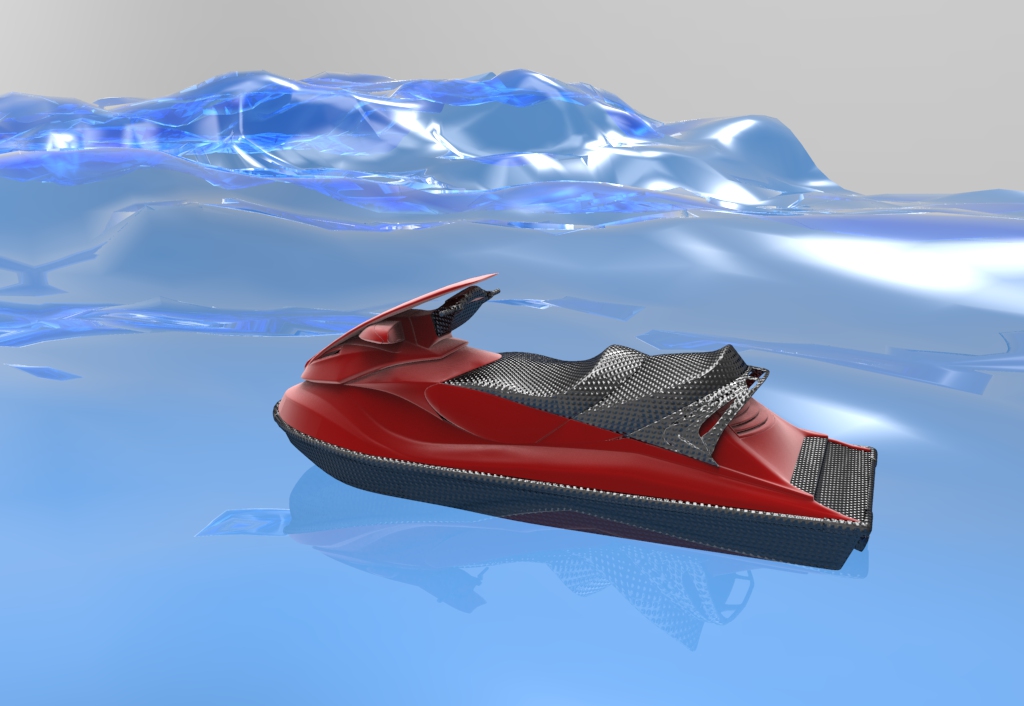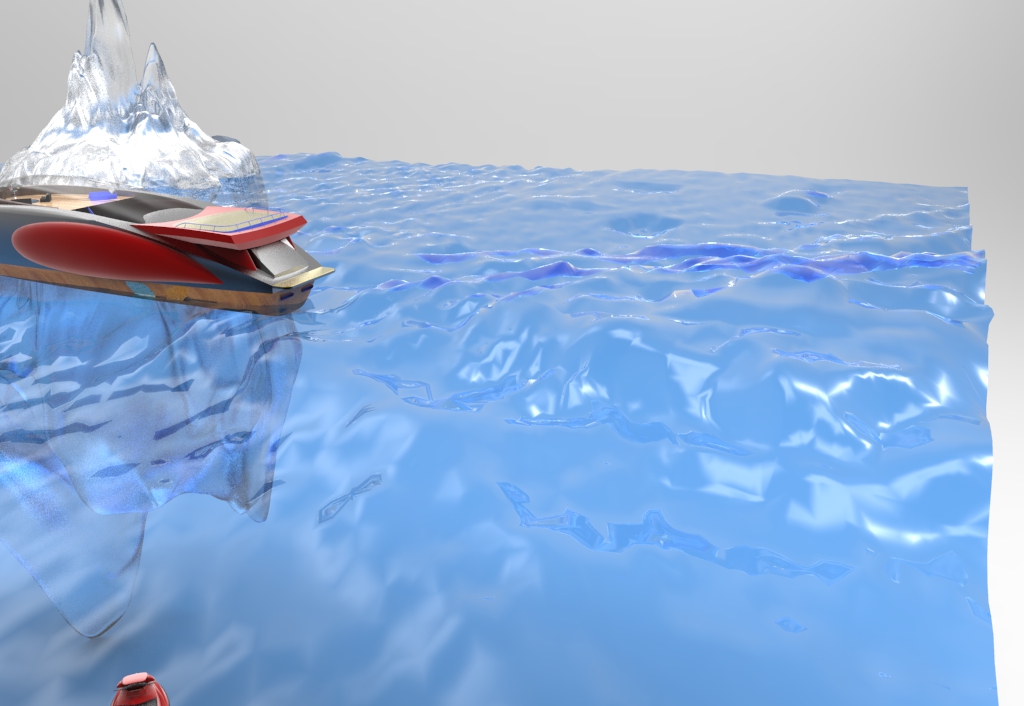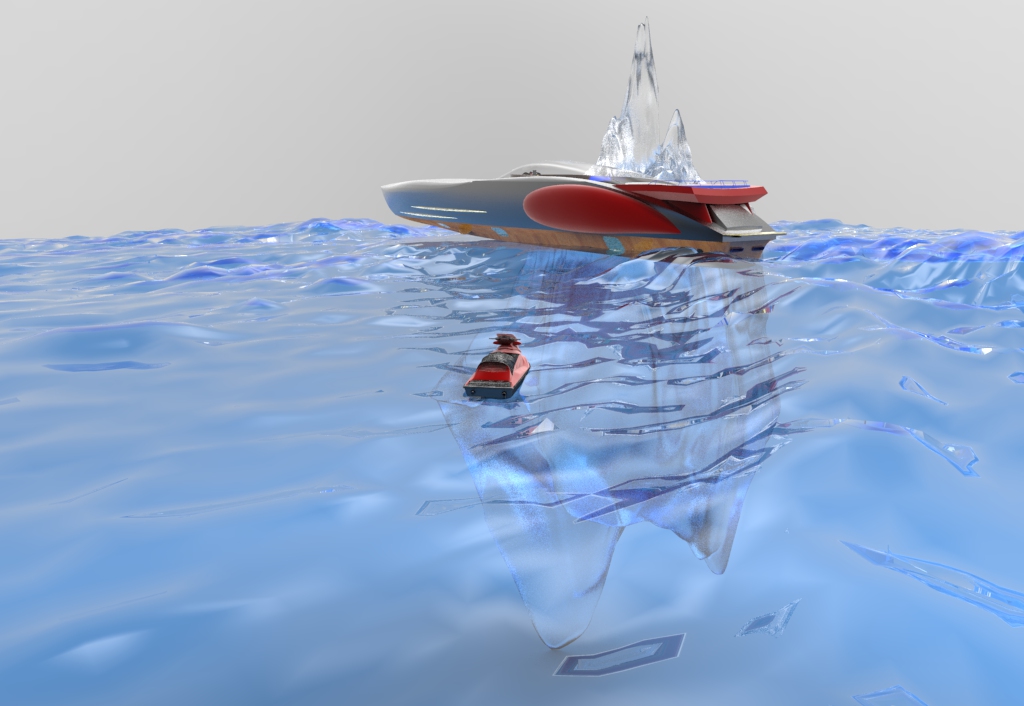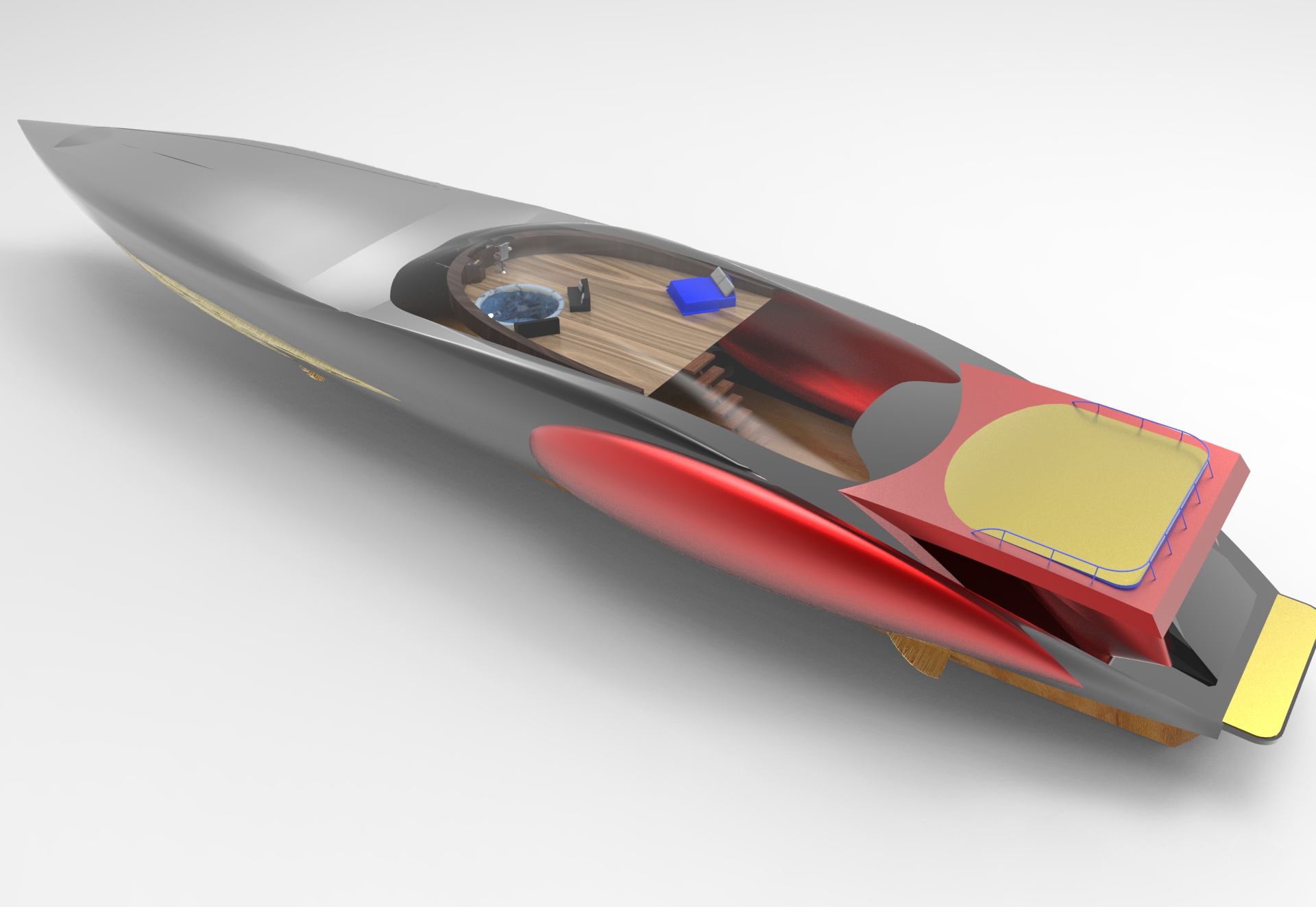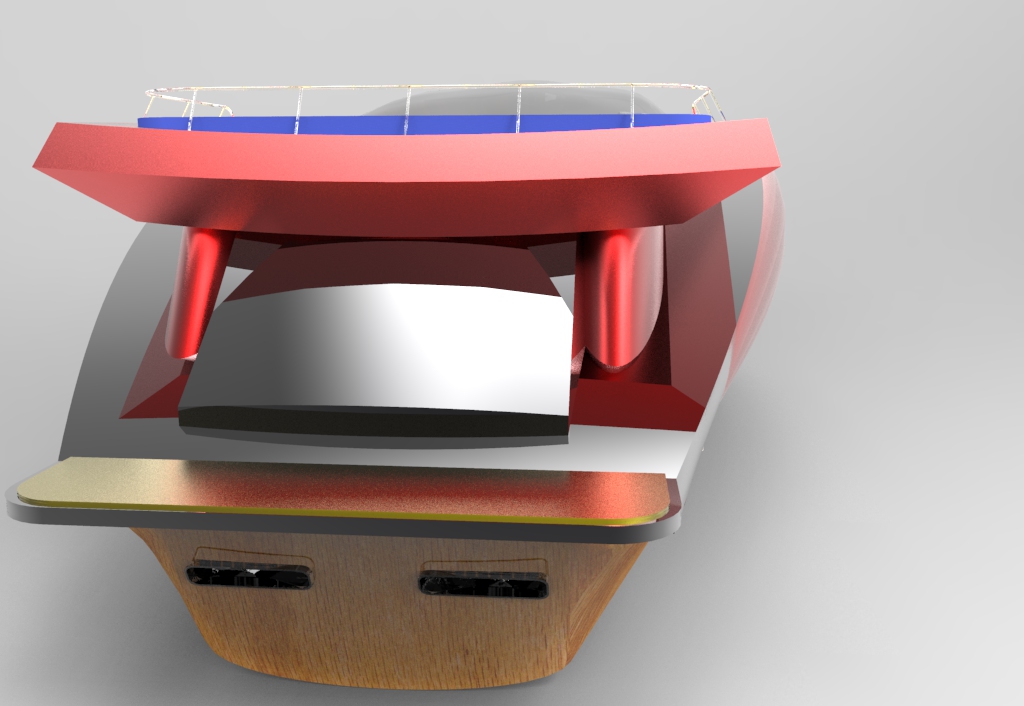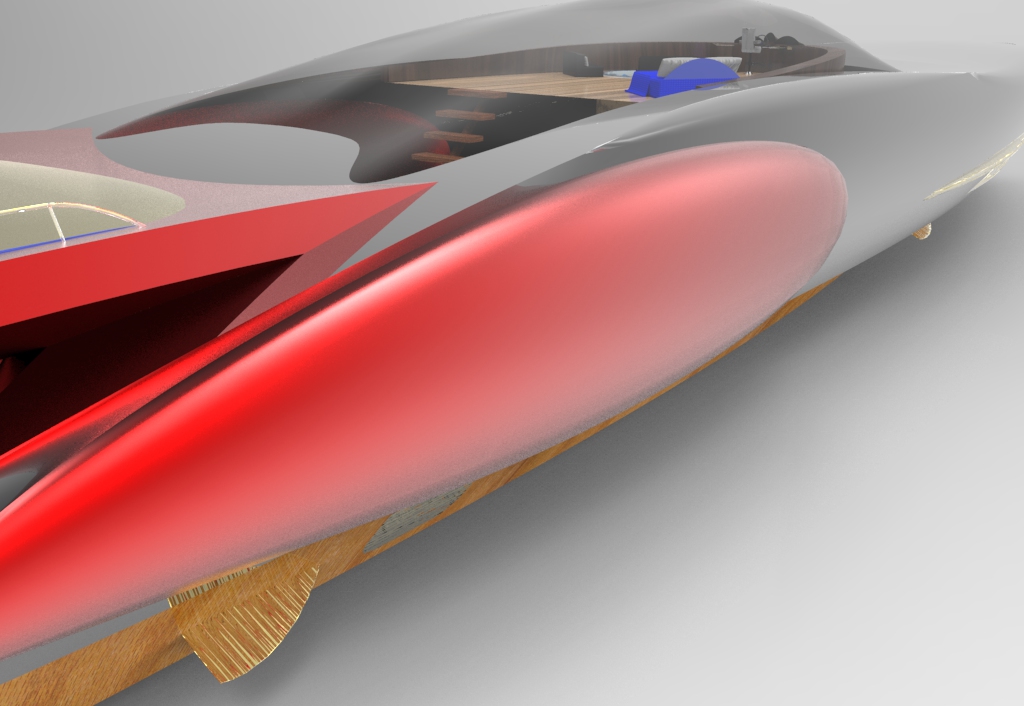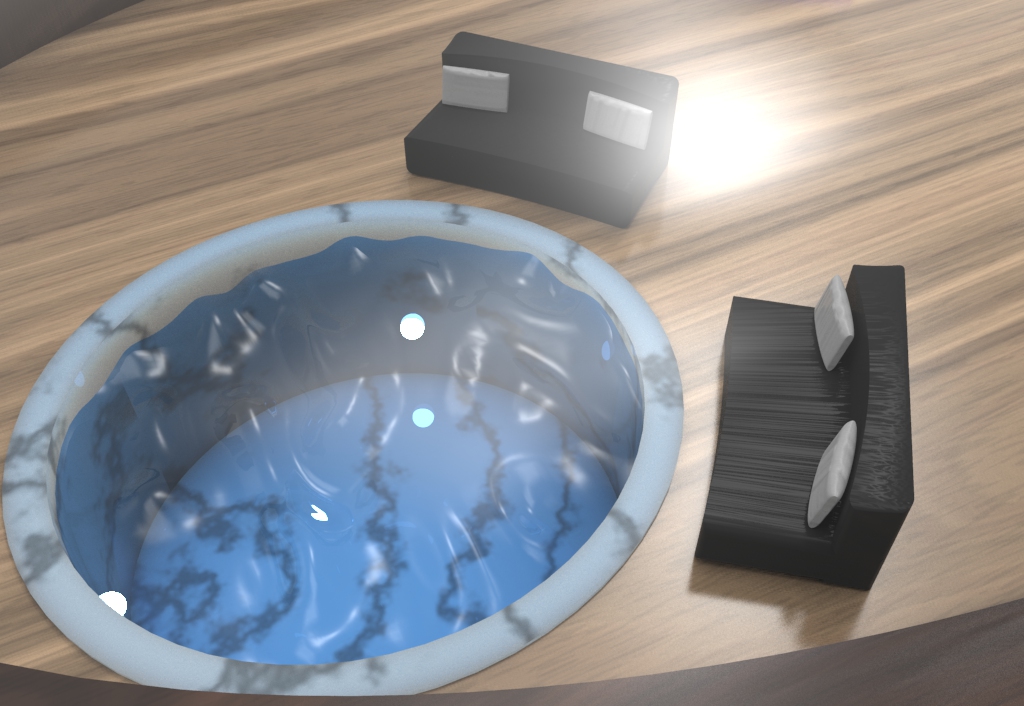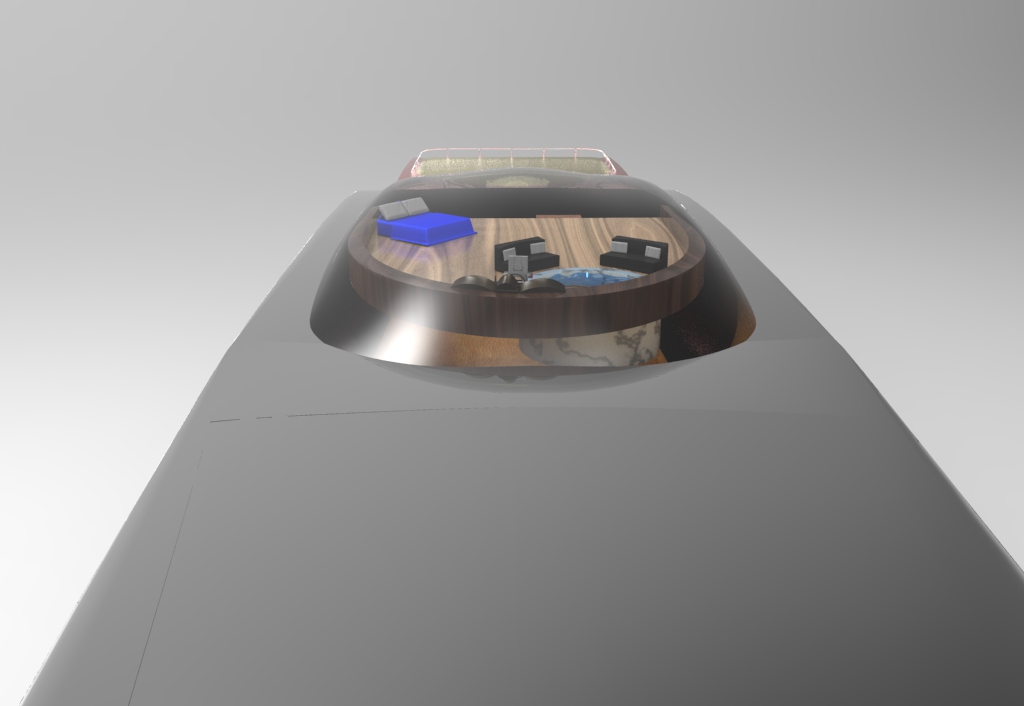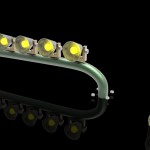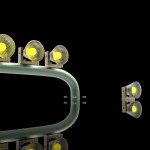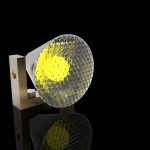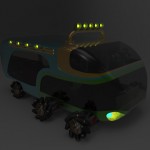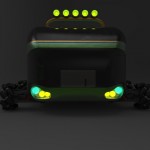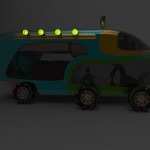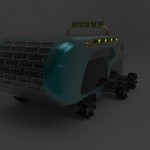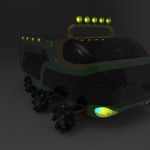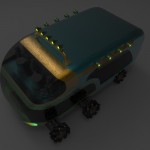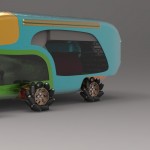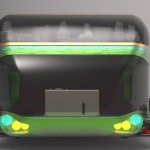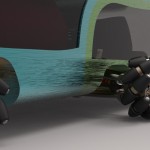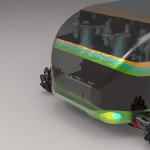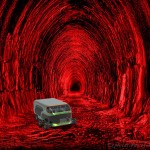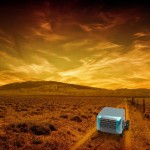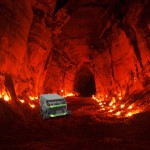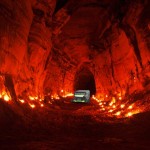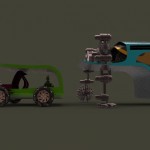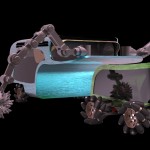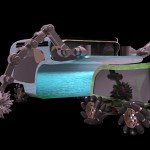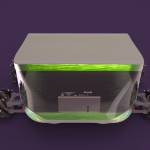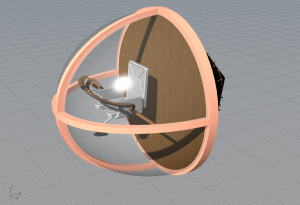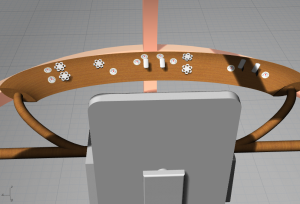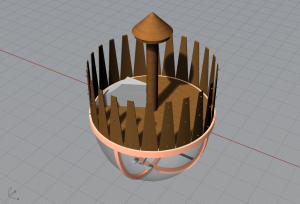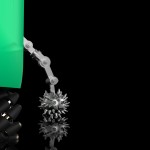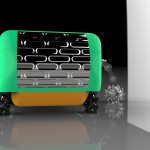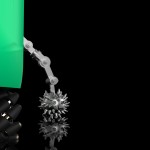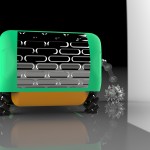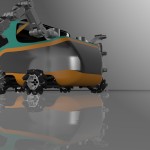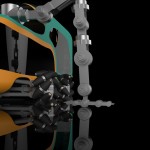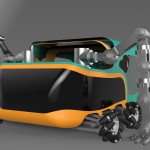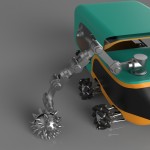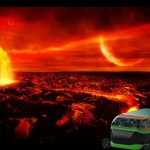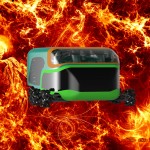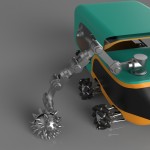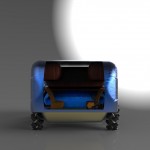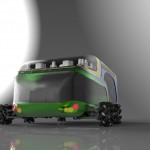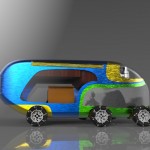Trying the wings opened and closed in keyshot. The closed wings are asymmetrical to be able to overlap on the back. A test material made in photoshop is applied. need higher res
Month: March 2013
Running Progress
Step 2: Narrative Research
For my narrative I decided to use Hannibal’s route as he traveled across land to attack Rome. Rather than move his fighting force across the sea and make his attack obvious to the Romans he decided to march his army across land, across the Pyrenees, through France (Gaul at the time) and over the Alps into the northern part of Italy. He started his attack leaving New Carthage in 218 BC and marched to Italy, losing many men to the tribes they had to fight through and the harsh conditions of the alps. Once Hannibal arrived in Italy, his campaign caused both the Carthaginians and the Romans heavy casualties, but thanks to the element of surprise and the position Hannibal took, his army had the advantage. Finally at the Battle of Zama, the Romans managed to out maneuver Hannibal’s troops and force a surrender.
I plan to use Hannibal’s troops crossing the fields of Gaul, Hannibal’s forces crossing the Alps, and finally the Battles in Italy as scenes for my project. For the part where Hannibal is crossing through Gaul, I plan to use a scene where the Wasp is feeding on the nectar of flowers. For the part where Hannibal crosses the Alps, I plan to use a scene where the Wasp is in flight over snow covered mountains with Hannibal’s armies below. Finally for the scene where Hannibal is at war with the Romans, I plan to use a Wasp attacking something with its stinger.
Intermediate 130328 – 2
Intermediate 130328
Step 3: Reference Images
Stink Bug shown without wings. Leaf model with a high res. leaf texture in keyshot
Concept Sketches/Art
Testing RhinoHair for hair, grass
Click to install the RhinoHair plugin: RhinoHair (website)
Open the zip file. It’s probably in your Downloads folder. Extract the file to someplace you know where it is (Desktop).
Right click on the file > Properties > Unblock. This unblocks the file because it came from the internet, and Rhino doesn’t like blocked files.
Drag the file (rhinohair.rhp) into an open Rhino session. It should say “Drag and drop loaded plug-in to [file location]”.
Good job. The (only) command to use the plugin is “RhinoHair”.
For reference: 50,000 hairs, length=1, segments=3, sides=3, other settings=default; takes 65 minutes on the lab computers. The program goes through 3 iterations per hair, so 1,000 hairs requires 3,000 iterations. Every 1,000 iterations generally takes 20 seconds, so you can roughly calculate how long it takes to grow your own hairs.
Step 2. Story: Gulliver’s Travels
Gulliver’s Travels (by Jonathan Swift, 1735) is a story about a man (Gulliver), who travels the world and finds himself in mysterious places. Most prominently, he travels to a land of giants, a land of very tiny people, a floating island inhabited by scientists, and a land governed by logically-thinking and English-speaking horses. In each of these and other places, he is initially captured and then utilized in some way, such as for entertainment, military use, or simple conversation.
The major events in this story are Gulliver’s travels themselves. It is interesting and exciting to read the descriptions of the people and society of each civilization he encounters. It brings to life what many people might daydream about:for example, what would it be like to be a giant in a land of 2-inch tall people? Gulliver fully takes advantage of the environments he finds himself in; he impresses the “tiny people’s” royal court by dashing over mountains, which to Gulliver, is simply jogging around. The climax of the story occurs when Gulliver looks back on his ridiculous encounters and rejects human society and his home of England, for what he now sees as equally ridiculous, and chooses to live by himself with horses.
I plan to have three scenes: 1) a tiny spider mite clambering over a rock (as we normally see them), 2) a huge spider mite walking over or approaching a city, and 3) a winged spider mite flying into the sky. The first two will resemble Gulliver’s travels to small and giant lands, while the third will show the mite’s utter rejection of reality (not having wings) and flying away.
Step 2: Narrative Research
For this project I chose the story of Aladdin. This story actually lends itself well to adaptation with the insect of my choice, the Red Spotted Purple. The butterfly has several larval (caterpillar) stages and finally emerges as a vibrant winged insect. In the narrative Aladdin meets a beautiful girl, falls prey to an evil magician, and makes deals with two genies. Different stages of the butterfly’s life cycle can be used to exemplify the characters in the story.
Some moments which would be thematically and visually appropriate are:
When Aladdin meets the genie of the ring
When Aladdin meets the genie of the lamp
When Aladdin moves from his small homestead to a vast mansion
When Aladdin meets the princess
When Aladdin is trapped in the cave of wonder and discovers vibrant and brilliant fruit like gems
For this story the main changes will be to appearance. Obviously it is not possible to make a beautiful caterpillar in the human sense, but it may be possible to make one that is very distinctive. Additionally, in the story the genie of the lamp is repulsive which is something that merits change for the final renders (Though there are two butterflies that are similar in shape but coloring differs. The less vibrant could be used as the “ugly” genie).
Glen Williams: Step 1: Stink Bug Research
The stink bug, or pentatomidae are a family of shield bug. They are small beetles with a shield shaped body, with widely varying colors and shapes of both their adult forms and nymphs. They get their name from their ability to secrete a foul smelling, cyanide containing liquid when threatened. This response as, well as their overall resilience, long life, and resistance to pesticides makes them relatively invulnerable to humans and predators. Some stink bugs can live for multiple years even in non-tropical climates.
Culturally, stink bugs are generally hated for their foul odor, tendency to infest human structures and trees, and their tendency to feed on crops as pests. Since they are unaffected by many pesticides they can decimate domesticated crops or garden plants. A minority of cultures consider stink bugs to be beneficial because they are sometimes predators of other beetles. People in Laos eat stink bugs.
I chose stink bugs/ shield bugs because I think they would go well with a story of trickery, infiltration, and invasion because shield bug nymphs often look nothing like their adult forms and sometimes grow up to become ferocious pests or predators. They are also attracted to heat/light, as some humans are attracted to gold. They have also invaded the mid-atlantic United States in the last decade and I have been seeing them nearly every day for years, have a very good notion of their body plan, and I hate them/would enjoy putting them into a story as an antagonist.
Step #1: Insect Research, The Mantis
The mantis belongs to the Mantodea order of insects. Its more well-known English name is the “praying mantis”, which identifies the insect for the “praying” posture its two front, spiked limbs, or “raptorial legs” (meant for catching and grasping this insect’s prey), fold into. Praying mantids can see up to 20 meters with their compound eyes (made up thousands of photoreceptor cell clusters) that afford them a binocular field of vision and precise, stereoscopic vision for close ranges. The mantis is an insect that hunts (and largely by ambushing its prey, since it is camouflaged either by coloration or environmental mimicry, standing perfectly still until its target is close by that it either can grasp it or it can easily pursue), relying heavily on its vision. Many mantid species will fly at night (to avoid predators such as birds), especially males looking for the less mobile females. One neat trick up the mantis’s sleeve is that it has a special organ that allows it to detect the echolocation of bats and ultimately avoid and evade these predators. The mantid’s diet changes as matures/grows, starting off by eating small insects (and even its own siblings!), and larger mantid species prey upon small creatures such as lizards, frogs, birds, snakes, fish, and rodents.
Praying mantids have been used as a natural/biological form of pest control (some gardening stores have sold mantis egg cases for this reason). However, while mantids will eat pests, they will also prey on beneficial insects, so this form of pest control is not without a few drawbacks. While the insect has involved in many Western writings, as well as a representation of courage and fearlessness in some ancient Chinese texts (i.e. the Erya), one of the most interesting cultural takes on the mantis come in the form of Martial Arts. Two different Chinese fighting styles/arts have come about based on the mantis itself. In Southern African indigenous mythology, the mantid is viewed as a god, which only further exemplifies how it is viewed with respect and admiration.
As a kid, my brother and I would often go outside to catch insects, such as grasshoppers and the like, and a praying mantis was always the best and most fascinating find. I hope to “fascinate” the viewers of my final image series/renders with my mantid subjects as the insect fascinated me as a child.
Rivera, Red Spotted Purple
Red Spotted Purple female butterflies prefer to lay eggs along the tips of cherry or willow leaves near water courses or along power or gas line right of ways near forest edges. Once the egg hatches into a young first instar caterpillar, it begins to feed around the vein of the leaf; creating a conspicuous perch and then extending that perch with dung and debris. As shown, the butterfly is a striking blue with some red or orange accents on it’s wings, though the caterpillars are less ornate – usually a brown to use as camouflage. The Red Spotted Purple is also very similar to the White Admiral. The two share the same body structure, and only differ in habitat and coloring. The Red Spotted Purple is indigenous to the eastern part of the United States and feed particularly on sap, rotting fruit, and dung.
The Red Spotted Purple lays a single egg at a time which is unusual in insects, though is common for many types of butterflies. Traditionally, laying many eggs is advantageous for animals which fall near the bottom of the food chain.
Not many stories or folk tales are recorded about this rather inconspicuous butterfly. Few contemporary writers even mention it. One instance of this is May Swenson’s poem “Unconscious Came a Beauty” (Shown below).
Step 3 – Visual References
Step 3. Pics
Plan to mostly focus on ants, with the caterpillar functioning as the firetruck (thing that burns the books). In my story, books = leaves.
Step 2 – Narrative Research
Solipsism, from Latin solus, meaning “alone”, and ipse, meaning “self” is the philosophical idea that only one’s own mind is sure to exist. As an epistemological position, solipsism holds that knowledge of anything outside one’s own mind is unsure. The external world and other minds cannot be known, and might not exist outside the mind. As a metaphysical position, solipsism goes further to the conclusion that the world and other minds do not exist. As such it is the only epistemological position that, by its own postulate, is both irrefutable and yet indefensible in the same manner.
I want to create the Solipsist Pill Bug, a theoretical entity that will be the only entity that owns reality. In other words, the point of the of the pill bug is the only correct and everything around the pill bug does not exist by itself.
In scene 1 the pill bug will be looking at a certain direction. What the pill bug cannot see will be fade out.
In scene 2 the pig bull will look in another direction and the same thing will happen. The rest of the scene will be gone.
In scene 3 the pill bug roll into a ball and all the scene will fade out.
Step 2. Paper burns at 451°
Fahrenheit 451, by Ray Bradbury, is a book about a dystopia where books are outlawed and people are persecuted for owning them. Society is slowly devolving and some technology is regressing. The story follows Guy, a fireman responsible for burning the books (haha irony) but instead keeps a collection of his own. The book basically outlines his world and his eventual escape from it. (read the rest on SparkN°tes). I chose this story because the persecution and loss of knowledge seen to flow together into something that could be directly translated to insects. Also, the similarity between the hive minded ants and the society made a connection randomly in my mind.
The scenes I have in mind is Guy salvaging a book from a discovered collection, the government chasing after him, and his eventual escape. These may not end up being the 3 scenes.
Step 3. Spider mite pictures
Step 1 Insect Research – Pill Bugs
Armadillidiidae is a family of woodlice, a terrestrial crustacean group in the order Isopoda. Unlike members of other woodlouse families, members of this family can roll into a ball, an ability they share with the outwardly similar but unrelated pill millipedes and other animals. It is this ability which gives woodlice in this family their common name of pill bugs, roly polies, chiggy-wigs or potato bugs. The best known species in the family is Armadillidium vulgare, the common pill bug.
Because of their unusual yet non-threatening appearance, some Armadillidium vulgare are kept as pets in areas throughout the U.S., typically among children. Among adults, they are often seen as unwanted (but essentially harmless) home pests. Keeping a pet pill bug requires a very moist habitat with limited light and lots of decaying plant matter They can often live up to three years. (Source)
During my whole childhood I played with pill bugs. I have felt a little bit guilty since then because I tortured and killed many of them. They become an important component of my childhood. It always called my attention its ability to roll into a ball (a transition from a flat plane to a sphere).
I think they are amazing living things and as I child I always complained because I could not understand how come pig bull were no presented in cartoons ( rabbits, cats and rats were more popular).
Step 1. This is how we get ants
Ants are hive animals, most species with a queen controlling everything. Within the household, they are considered pests, eating food or destroying the structure (carpenter ants). However, outdoors, they serve as scavengers to help break down decomposing life. There are several species of ants that will form a symbiotic relationship with another insect. Aphids and caterpillars are examples of this. The aphid / caterpillar will provide the ant with nectar or some sort of sugary secretion. In return, the ants will groom them. This allows for the aphids and caterpillars to have guards around them almost all the time. Research as shown that the caterpillars will secrete more of the sugary substance when they feel threatened in order to influence the ants to stick around and protect them. This protection does not extend to the caterpillar’s butterfly stage, where the ants will consider the butterfly fair game.
In terms of physiology, there are generally three classes of ants within a hive. A queen lays eggs and directs the rest of the hive. All workers are female and do most of work; scouting, scavenging, tending to the larva. The males are haploids (only ½ of DNA), and don’t do much beyond reproduce.
Step 1. Bug research – Red spider mite
I have chosen the red spider mite, also known as a velvet mite, or simply “red mite”. This arachnid hails from the order Trombidiformes, which includes the majority of known mites and similar species. The red spider mite is common in temperate climates across the globe, and comes in many shapes and sizes. In the US, these mites range in size from microscopic to the size of a fingernail. As its name implies, the mite is a deep red, and its body is entirely covered with short, dense hairs, giving it a fuzzy or velvety appearance. The body of the mite resembles a crumpled ball or a human brain. Most people in the US encounter red spider mites as tiny red specks scuttling over rocks in the summer. Much larger species live underground and hunt small insects. All species are parasitic to long-legged insects (such as spiders and grasshoppers) at some phase in their life cycle. Some species have their largest eyes mounted on stalks, which is uncommon for arachnids.
I specifically chose the red spider mite because I have always thought it was an interesting animal from when I was a kid, when I would squish all of the “red dots” with my finger. After seeing one under a microscope and learning more about them, spider mites are pretty interesting (and look cool, like a fuzzy brain). Spider mites are culturally linked to India, where they are used in rudimentary and alternative medicine for treatment of paralysis and inhibited sex drive. As such, these mites are also known as “Indian Viagra”. In India, they appear in great numbers before the monsoon season, and so are referred to as “rain mites”. And, perhaps unsurprisingly, the largest species are collected and eaten.
Step 3: Potter Wasp Reference Images
I’ll come back to step 2.
Step 1: Potter Wasp Research
Vespidae Eumeninae
For my insect I have chosen the Potter Wasp. I chose the Potter Wasp due to my long standing relationship with wasps where they sting me while I am working outdoors and my subsequent retaliation at dusk (using a can of Raid).
The Potter Wasp is an insect that likes to build its nests underground or using existing holes and cracks as a starting location. Potter Wasps build their nests using dirt, clay, sediment, and plant matter to construct a nest where they will gather food and lay their eggs. Once they have laid their eggs and gathered enough food for their babies, they seal everything in until the babies hatch and mature. They are typically not very social insects, but they will build their nests in a common location with other Wasps. Potter Wasps are predatory insects that will feed on other insects in the larvae stage and then on plant nectar once they are full grown adults. While they travel from plant to plant drinking their nectar, they will gather pollen from the plants and deliver it to other plants pollinating the plants and helping the plants they feed off to reproduce.
Potter Wasps are colored with bright strips of Orange, Red, and Yellow mixed with either each other or with Black in a camouflage-like appearance. They are often perceived as a malevolent pest that will attack unprovoked and I was raised to kill wasps using the aforementioned can of Raid. Even though they are seen as a pest by the general population, they only harm other insects in nature and are used to pollinate flowers. They have a warrior like presence to them where they can hunt and attack other insects.
Water Strider- Part One Research…
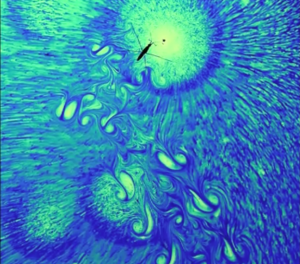
The water strider is an insect that is noted for its ability to “walk on water”. Often referred to as the “Jesus bug” or “pond skater”, it is among only a few types of insects that can do this trick. Their specially evolved bodies not only allow them to float, but also bounce on the water, travel very quickly across the surface, and support up to fifteen times the weight of the bug. Each of their legs has thousands of microscopic hairs that trap air and create buoyancy. This air cushion allows them to balance and propel forward using surface tension.
The body is a about one centimeter long and their two, back long legs are the ones that help them stand on the water. Their shorter front legs are designated for catching prey. Mechanical engineer, David Hu at Georgia Tech did a study with food coloring to prove that water striders do not really stride, but row through the water. They “generate a vortex with each stroke”, deforming the “film-like” surface of the water and using it to move forward. They also only weigh a couple of grams, so their legs are the right length to keep them afloat. Hu calculated that if humans were to build shoes that have the same capabilities (as Da Vinci once sketched in his notebook) they would have to be a kilometer in diameter.
The water strider is fascinating to me because its overall appearance does not imply that it is a unique specimen. It does not have unusual coloring, an oddly shaped body, large wings, or specially evolved eyes. The beauty of this insect comes from its movement, which will make it fun to model and imagine in a dynamic setting. I look forward to working on this project.
Water Strider
Step 1- Insect Research
Dragonflies belong to the order ‘Odonata’ and suborder ‘Epiprocta’. They have eyes that are so large, they allow them to see nearly everywhere except directly behind them. They also have a strong transparent wings helps it live in its daily life. Dragonflies have 6 legs but do not walk well. They are one of the fastest flying insects in the world. Their wingspan is usually only 2-5 inches. In the larvae stage, dragonflies live in water and break out of their exoskeleton. Dragonflies are harmless but catch all their prey (and food) while flying, so they will starve if they cannot fly. They can travel up to 100 miles in a single day, but most don’t usually travel that much. They are usually about 1-5 inches in length with very short antennae.
In Europe, culturally, dragonflies are seen as evil and sinister, and sometimes even personify the devil, while Native American culture had them representing swiftness and activity in stories. In certain parts of Asia, dragonflies are eaten as delicacies, but in Japan, they are the symbol of courage, strength, and happiness in haiku poems.
I chose a dragonfly because while there are so many things the body can do, from moving its wings to its eyes, its still flies gracefully. The wings as paper-thin as they are often glisten in light, and I hope that comes through in my Keyshot renderings. I plan to place the dragonfly in a story that takes place near water of sorts because that’s where dragonflies are most commonly found.
Step 3- Dragonfly Reference Images
Step #3: Reference Images
Here is my initial collection of reference images for my idea/project/insect:
My idea, if you couldn’t begin to tell, is to re-create the climactic scene when Rocky, in Rocky IV, delivers the knock-out blow to Drago (the Russian boxing villain who also kills Rocky’s friend at the start of the movie) and win the final match (after taking quite the beating). Of course, Rocky will be “Rocky Mantid” and Drago will be beefier, stronger praying mantid.
Step 3 – Visual References
Step 2 – Narrative Research
I chose a Japanese story because the Japanese have a strong cultural connection to the firefly and many interesting traditions surrounding it. The story says that there was once a man and women who lived in a forest near Mount Fujiyama in Japan. The couple wished for a child but had not been able to conceive. One night, the women lay beneath the great mountain and prayed for a child. As she prayed, a light appeared from the top of the mountain and drifted towards the women. When the light reached the women, she was overjoyed to see that it was a Moonchild sent from the Lady of the Moon. The couple raised the moonchild and she grew to be the Moon Princess. At the climax of the story, the Emperor’s son falls in love with her and wishes to marry her. The girl refused because she had to return back to her mother when she turns 20. On that day, the Lady of the Moon sent down a beam of light and the Princess floated up towards the moon while her family and loved ones watched. As she floated, she cried for those she had to leave behind. As the tear fell they became silver and traveled across the land. Today, her tears can still be seen on moonlight nights.
There are a few big moments in this Japanese myth. The three large moments that stand out are when the mother receives the child from the Lady of the Moon, when the Emperor’s son falls in love with the Moon Princess and when the Princess must leave her loved ones.
For the purposes of this project, I believe I will change the story slightly so that the Moon Princess gives gifts to her loved ones before she leaves. She will perhaps give them a light in some sort of glass jar or container. This has a strong connection to how I think of fireflies because I often caught them in jars as a child. She can give them a gift so one of my frames can include the bugs in a container. When she leaves she can still cry and allow them to spread across the land.
Here is a link to an article I found about the use of Keyshot in industrial design and CGI. It is amazing how far CGI has come and car companies, LEGO, and many others use Keyshot to make their commercials.

Microsoft used Keyshot in the development of their Surface Commercials.

Images from the LEGO company using Keyshot to make commercials.

Half of this image is real and the other half is CGI. Can you tell which is which?
Step 1 Insect Research- Fireflies
I selected the firefly because I find their glowing very interesting and always enjoyed catching them as a child. The firefly is classified under Lampyridae in one of five families. The Photurinae firefly is most common in North America. Interestingly, not all fireflies light up although that is what they are known for.
Fireflies use their light for communication as well as defending their territory, warning off attackers, and attracting a mate. In most firefly species, both genders glow. The male will fly while the female remains mostly stationary in trees, grasses and shrubs. When the female spots an attractive male, she glows to signal him.
Firefly’s tails contain two chemicals, which allow them to glow. The tail contains luciferase and luciferin. These two chemicals glow when under the right conditions. ATP in the body of a firefly will convert to energy and initiate the glowing. The chemicals found in the firefly tail can be used by doctors and researchers. When these chemicals are injected into diseased cells, they can detect anomalies, which can help identify different diseases such as cancer. Along with adult fireflies, the firefly egg has also been observed flashing in response to some type of stimuli in it’s environment.
Fireflies exist on all continents except for Antarctica. They enjoy warm, humid areas and often come out during the summertime. Because fireflies can be found all over the world, there are many different myths surrounding their glowing. I spent a lot of time as a child trying to catch fireflies and their presence would signal the beginning of summer for me.
Prof. Meiser,
http://hackaday.com/2013/02/
http://hackaday.com/2013/03/

No matter how good a 3D printer gets, you’re always going to have visible print layers. Even with very high-quality prints with sub-0.1mm layer height, getting a shiny and smooth finish of injection molded plastic is nearly impossible. That is, of course, until you do some post-print finishing. [Neil Underwood] and [Austin Wilson] figured out a really easy way to smooth out even the jankiest prints using parts you probably already have lying around.
The technique relies on the fact that ABS plastic and acetone don’t get along together very well. We’ve seen acetone used to smooth out 3D printed objects before – either by dunking the parts in an acetone bath or brushing the solvent on – but these processes had mixed results. [Neil] and [Austin] had the idea of using acetone vapor, created in a glass jar placed on top of a heated build plate,
The process is pretty simple. Get a large glass jar, put it on a heated build plate, add a tablespoon of acetone, and crank the heat up to 110C. Acetone vapor will form in the jar and react with any printed part smoothing out those layers. The pic above shows from right to left a 3D printed squirrel at 0.35 mm layer height, 0.1 mm layer height – the gold standard of high-end repraps – and another print with 0.35 layer height that was run through a vapor bath for a few minutes. Amazing quality there, and cheap and easy enough for any 3D printer setup.
You can check out the tutorial video after the break along with a video showing exactly how dangerous this is (it’s not, unless you do something very, very dumb).
T-Splines “unknown command” problem
 – – –
– – – – – –
– – –Dear Students,
I wanted to send a quick note to reiterate the importance of reading the T-Splines manual and watching the video tutorials available online. These resources were incredibly helpful to me as I was learning to use the software, and I think you’ll gain a good understanding of the program from them.
For getting started I suggest the basic tutorials at: http://www.tsplines.com/
As you progress with your model, try to also watch some of the advanced tutorials available on this page: https://www.tsplines.com/
Please take a look at the class calendar for instructions on submitting your weekend exercise. Do let me know this weekend if you have any trouble with your models. I’ll be happy to try to answer your questions by email, talk with you over the phone, or setup a meeting with you to talk in person.
take care,
Prof Meiser
adding holes to the hippo
Hello Professor,
Thank you,
Jordan Rivera
Jordan,
Your model looks great! It looks like you’ve been working very hard on the exercise. I suggest adding the holes in T-Splines. I created an example below that illustrates the basic strategy for doing so…
To get started with this example, I created a quad ball and then subdivided it.
Then I started aligning the edges to the desired location of the big hole.
And did this for the small holes as well.
And then I selected all the faces I wanted to delete.
And as you can see, the model went crazy when I did the faces, because in T-Splines what you do to one edge will have an effect three edges out, so the hole interfered with the smoothness of the neighboring faces.
Next I adjusted the points to get them basically where I thought they needed to be, ignoring the semi jagged nature of the geometry.
Then I selected the edges of the holes and extruded them down a couple of times. Doing this makes it possible for the faces surrounding the holes to smooth out. You could achieve the same result by thickening at this point; however, there’s still a lot of refining to do to the outer form, and if you thicken now you’ll need to adjust both the inside and outside points at once in order to preserve a consistent wall thickness. So it’s better to just use temporary extruded edges to make the model smooth while you continue to refine it.
Next, I worked on adjusting the points to create a better looking, more even surface.
It’s helpful to toggle to box mode so that you can be sure the underlying geometry is consistent and regular.
When you’re totally finished refining your model you’ll want to select those edges you extruded inward earlier and delete them.
Again, your model will go crazy, but this is temporary.
Once you use the thicken command your model will smooth back out. If, while running the thicken command you get a strange result, then try selecting smooth edges rather than creased edges in the command line.
This example isn’t perfect. If I were doing this for my own artwork I would refine the topology much more to get a smoother result, but this quick example at least illustrates the basic strategy for adding holes to a model.
I couldn’t resist sending some weblinks for more information (excuse the generality of wikipedia, but it is a good source to start!)
Let me know if you’d like more!
Pillbugs:
http://en.wikipedia.org/wiki/
Insects as Food (for people!)
http://en.wikipedia.org/wiki/
Tsetse fly trypanosomiasis
http://www.who.int/
Sleeping sickness & tsetse life cycle:
http://en.wikipedia.org/wiki/
Another tropical disease vectored by insects: river blindness
http://en.wikipedia.org/wiki/
Saavedra, Final Renders
Bunny Screenshots
Finished model:
Process images:
T-splines exercise reference photos
T-Splines is a powerful solution for creating organic forms. You’ll be amazed at what can be accomplished with the program.
http://www.youtube.com/watch?feature=player_embedded&v=9kYdmBfmh4M
Basic T-Splines Tutorials: http://www.tsplines.com/support/basictutorials.html
Advanced T-Splines Tutorials: https://www.tsplines.com/store/tstutorials.html
Make Human
Make Human: An open source tool for making 3D characters http://www.makehuman.org/
Our group chose to focus on a vehicle of a yacht in the arctic. What is interesting about this is the fact that we chose these two in tandem because we felt as though we were “solving the Titanic” so that the yacht may not ram itself into icebergs, but rather scale over them with cramp-on type feet and hinging legs, another extra unique element to our vehichle. Our character was James Bond, which is perfect for the lavish vehicle of a yacht, and it was interesting building such a large space for use by only one individual. The renderings I chose in the order I chose to display them reprensent someone moving through the space with the yacht in the water. Suddenly, it releases into “leg mode” and has a duck-type look with its legs floating beneath it. Then we slowly begin to see the vehichle move closer to the iceberg and begin to climb and we once again get the feeling of moving around in space due to the order in which I chose to display the images and shots.
We used Scooby Doo van and an excavator machine. We chose this vehicle because we could not decide for a final concept. At the end we decided that each one of the group will decide one aspect of the project. Tali chose scooby doo, jordan chose the type od device and I chose hell.
We came up with different models. We assumed that hell is undergound.
Team 3: Project Paragraph
My group chose to design and model a boat equipped with ice-climbing legs for James Bond traveling in an Arctic environment to stop an evil villain’s plan of speeding up the process of global warming with his sinister global temperature decimating satellite. We chose a yacht combined with these special gadgets because we felt the vehicle was interesting and would be something that James Bond would use (given by Q) to travel such an environment. James Bond’s personality permeates the boat, ranging from the integration of class and modernism to style and sleekness. The Martini glass is one example of the “class” inserted into the deck of the ship.
Nate Hill Summary
The primary inspiration for the vehicle in this project was a yacht. This particular type of boat was chosen because it was one of the vehicles least likely to be found in the Arctic, which is our chosen setting. The yacht was chosen specifically because it is a luxury craft whose purpose is to transport wealthy and important people in style. We designed this boat for James Bond, who would not travel in any watercraft less capable of conveying sleekness. James Bond’s usage of high technology was made evident by the futuristic controls used to control the yacht, as well as the fact the vehicle itself is a feat of engineering—it has legs! The legs were built to give the yacht the ability to walk up and over icebergs and glaciers, a common occurrence above the Arctic circle. Because Bond is famously suave and manly, we included a lush bed and relaxation area in the bridge of the yacht. Bond would also not travel to such a horrible place willingly—he must be there for a reason. This reason is the presence of a villain, made apparent by the scary-looking satellite dish shining a laser into the sky. The “story” presented in this project is that James Bond is traveling to the Artic to take down an enemy. To do so, he utilizes his climbing yacht. Afterwards, he relaxes in his luxury vehicle.
Our vehicle, a two-part flyer that is meant to traverse the harsh conditions of a volcano eruption, was inspired by master inventor and Renaissance man, Leonardo Da Vinci. We were drawn to his sketches and designs because he was truly ahead of his time. Therefore, it made sense that our futuristic plane based on the Cylon from Battlestar Galactica, with massive platoons, large boosters, and the capacity to hover over the lava, should be influenced by ideas conceived hundreds of years ago by Da Vinci. We also chose the historic location of Pompeii during the eruption of Vesuvius in 79 AD as our particular setting because it is also a legendary and historic event/location. We thought these two elements would compliment and play off each other since the volcano presented the problem and Da Vinci’s designs helped inspire us to generate a solution.
Inspired by hovercrafts, spy planes, submersible cockpits, and the design techniques of Leonardo Da Vinci, the Pompeii flyer is a modular vehicle designed for exploration. A flying and hovering vehicle was chosen because it is the best way to stay safe and out of contact from the incredible heat of lava and ash. Specifically, the environment chosen was a volcanic eruption near ancient Pompeii. The vehicle is shown arriving at the scene of an ongoing eruption and navigating lava, ash, and ruins of buildings. The renderings are intended to be viewed in order, as the ship arrives, transitions, and detaches the pod. Leonardo Da Vinci’s scientific nature, gravitation toward nature, and obsession with complex, probably impossible mechanisms inspired the design. For example, the airfoils of the wings are very birdlike, but are reversed from a direction that would actually cause it to fly. Very few of Da Vinci’s inventions would actually function, and several of them are incorporated into the vehicle, including the pod’s screw-like blades.
The vehicle rendered was a yacht that was designed for James Bond and the Arctic Ocean. It features legs that allow it to climb on ice, and avoid another Titanic-like disaster. Probably the most interesting feature is the legs that protrude from the bottom of the boat. They resemble insect legs and would allow the boat to climb on icebergs like an ant over a rock. Inside the cockpit, there is a Jacuzzi, several couches, and a bed, designed in a manner that would make James Bond proud. Also included is the jet ski, which would normally be stowed aboard.
When we made our project we decided to choose a volcano as a harsh environment and specifically we choose Pompeii as our location. Volcanoes are one of the harshest environments on the surface of the Earth and designing a vehicle that is capable of traversing one seemed a difficult and interesting task. While discussing the volcano, we were trying to figure out how the vehicle would transverse the environment and we decided on either having it fly or float on the lava. With this in mind, we choose a flying vehicle with pontoons on it to allow the ship to float and also to fly into the volcano. We pulled ideas from helicopters, hovercrafts, and especially from Sci-Fi movies such as Star-Trek and Battlestar Galactica. The Cylon Raider from Battlestar Galactica was the major influence on the fuselage of the main ship. Finally this vehicle was designed for Leonardo Di Vinci. With him in mind we decided on a helicopter as a pod using his famous helicopter design as an integral part. Since Di Vinci was both a loner and a man of extravagance, we made a large one-seat ship that reflected his personality and the fact that he was indeed before his time.
Rivera, Project Summary
In a combination of several eclectic elements from various sources this project focuses on a vehicle designed to transport the gang from Mystery Inc. through Christian Hell (Read – Fire and Brimstone). To accomplish this goal several inspirational vehicles were used including an RV, a small omni-directional robot, and an earth boring drill. The overall combination of these somewhat disparate elements resulted in the object pictured here, a large rolling home for the gang equipped with navigation, lights, and some solid robotic arms to combat a variety of situations. The purpose of this vehicle is not only to allow safe exploration, but a divide and conquer strategy as Fred exclaims, “Let’s split up, gang!”
Team 1 created a vehicle for Scooby and the Gang! When considering the famous individuals we created a list of constraints that would fit their needs. The vehicle had to be large enough to fit the team and it needed to be able to go with them on their wacky adventures. We designed a vehicle that could be used in hell. Our renderings also include a staging environment where the vehicle would be housed when it is not being used. The vehicle had to be able to drive on rough terrain and help the group find bad guys while keeping them safe. We created a van like vehicle with a smaller car that could detach from an RV. The small car is able to drive off to explore while the RV is stationed safely, housing the gang’s costumes and investigating equipment.
Ororbia Renders
new plugin installed
A new plugin has been installed in BERT 012 that links Rhino and Keyshot.
A note from our IT staff: “When testing the plugin, I found that you need to have Keyshot running before using the plugin in Rhinoceros because the plugin asks for the Keyshot license server. This setting is automatically set when you launch Keyshot.”
Unlike other plugins, a KeyShot plugin only “links” the 2 applications together, rather than putting KeyShot inside the modeling application. This makes the installation and use extremely simple and efficient. Since the two applications remain separate, they can easily operate side by side.
Each plugin works the same. Simply open the model in the supported application, and look for the KeyShot button in the menu bar. Select “Render”, and follow the instructions on the screen. Within seconds, KeyShot will open and drop your design into the default scene. Apply materials, change the lighting, move the camera. Done!
With KeyShot 4, we have taken the plugins for Creo, Pro/ENGINEER, SolidWorks and Rhino to the next level. When you download the plugin for KeyShot 4, you can now link KeyShot and the CAD application together. Now you can continue to work on your design, and update the model inside KeyShot with a simple button push. All your materials, animations, lighting, camera – simply everything – will be maintained. Do this today, tomorrow, or next week. All you need to do is open your model in the CAD application, and the scene in KeyShot – and you are live linked!
Another great feature of the plugins for Creo, Pro/ENGINEER, SolidWorks and Rhino is that KeyShot doesn’t have to be installed to get your design out of the CAD application into KeyShot. Simple select the EXPORT button in the plugin menu, and all the geometry, structure along with colors gets exported to KeyShot’s native file format.
http://keyshot.com/downloads/plugins/
Nate Hill, Final Renders
The Da Vinci inspired lava flyer, shown below arriving at an eruption at Pompeii:
Eric Lynn, Final Renders
Rivera, Final Renders
Rivera, Test Images
Tali Sason: Final Renders
41 renderings.
Dana Germano- Test Renders
Diefenderfer 22 Renderings
Nate Hill, 20 renders
Eric Lynn 20/20 renders pt 2
Eric Lynn 10/20 Renders pt1
Lights, Rivera
keyshot import problems
On Fri, Mar 1, 2013 at 3:26 PM, Tali Sason <tjs024@bucknell.edu> wrote:
Hey Seth
We are loading our rhino file into keyshot and the front wheels won’t load. We have no idea why this is happening. We had issues with other components because they were excruciation objects but we fixed that. The back wheels show up totally fine and they are an exact copy of the front wheels.
Help!
Any ideas?
Thanks-
Tali
– – –
On Fri, Mar 1, 2013 at 6:40 PM, Seth Berry <sethberry3@gmail.com> wrote:
i have no idea. try:
seth
– – –
On Sun, Mar 3, 2013 at 12:52 PM, Tali Sason <tjs024@bucknell.edu> wrote:
Exporting to Rhino 4 worked!
Thanks so much
Tali






